Welcome to the world of clucks and feathers! In this short but insightful blog post, we’ll take you on a whirlwind tour through the captivating universe of chicken breeds.
From the tiny to the grand, the prolific layers to the exotic rarities, get ready to be amazed by the diverse array of chickens that grace our farms and backyards.
Let’s dive right in and discover the charm and wonder each breed brings to the table. Whether you’re a seasoned poultry enthusiast or a curious newcomer, there’s something here for everyone. So, buckle up, because we’re about to explore the delightful world of chicken breeds like never before!
Chicken Breeds by Primary Use
If we categorize chicken breeds based on their primary use, then we can categorize them into six main categories:
Egg Breeds:
These breeds are prolific layers and are raised primarily for their ability to produce a large number of eggs. They are excellent choices for individuals or families looking for a steady supply of fresh eggs. Some popular egg breeds include Leghorns, Rhode Island Reds, and Australorps.
Meat Breeds:
Meat breeds are raised primarily for their meat quality and quick growth rate. These chickens are bred to have substantial muscle development, making them ideal for those focused on meat production. Examples of meat breeds include Cornish Cross, Broilers, and Red Rangers.
Dual-Purpose Breeds:
Dual-purpose breeds serve a dual function, excelling in both egg-laying and meat production. They are versatile choices for small-scale farming and backyard flocks, offering a balance between egg production and meat yield. Well-known dual-purpose breeds include Plymouth Rocks, Orpingtons, and Sussex.
Exhibition Breeds:
Exhibition breeds, also known as show breeds, are raised primarily for their aesthetic appeal and are showcased in poultry shows and competitions. These chickens have unique and beautiful plumage, making them sought after for their visual qualities rather than their egg or meat production. Breeds like Silkies, Polish, and Seramas are popular examples of exhibition breeds.
Bantams:
Bantams are smaller versions of standard chicken breeds. They are raised for various purposes, including eggs, meat (though in smaller quantities), ornamental value, and as pets. Bantam versions of many breeds exist, such as the Bantam Wyandotte, Bantam Brahma, and Bantam Sebright.
Hybrids:
Hybrids, also known as crossbreeds, are the result of crossing two or more chicken breeds to achieve specific characteristics. They are often bred for their high egg-laying potential, fast growth rate, or other desirable traits. Hybrids like the ISA Brown and Golden Comet are well-known for their exceptional egg-laying capabilities.
Each category offers a unique set of advantages, so choosing the right breed for your needs depends on your preferences, goals, and available resources. Whether you seek eggs, meat, ornamental value, or a combination of traits, the diverse world of chicken breeds has something to offer for every poultry enthusiast.
Now Let’s deep dive into each category and get familiar with the distinct breeds.
Eggs
These breeds are known for their exceptional egg-laying abilities, producing a high number of eggs.
Ancona
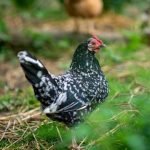
Country of Origin: Italy; United Kingdom
Use: Eggs
Weight Male: 2.5-2.8 kg
Weight Female: 1.8-2.1 kg
Skin Color: Yellow
Egg Color: White
The Ancona chicken is a breed originating from Italy, but it was refined and developed in the United Kingdom during the 19th century. Named after the city of Ancona, it is now popular in Britain and the United States, but relatively uncommon in its native Italy. Efforts to preserve its biodiversity and reintroduce it to its place of origin began in 2000.
This Mediterranean breed is known for its rustic, lively, and hardy nature. The plumage is striking, featuring black feathers mottled with white, often displaying a v-shaped white marking at the tip of one in every three feathers. The legs are yellow mottled with black, and the beak is yellow with some black markings. The Ancona lays approximately 220 white eggs per year, each weighing 50 grams or more, making it an excellent egg producer. Hens have low tendencies for broodiness, and pullets may start laying at five months of age.
In addition to the standard-sized Ancona chickens, there are also Ancona bantams available. Overall, the Ancona breed is cherished for its attractive appearance, prolific egg-laying abilities, and robust character, making it a favorite choice among poultry enthusiasts in various countries.
Andalusian

Country of Origin: Spain
Use: Eggs
Weight Male: 3.2-3.6 kg
Weight Female: 2.25-2.70 kg
Skin Color: Yellow
Egg Color: White
The Blue Andalusian chicken is a breed native to the Andalusia region of Spain, specifically concentrated in the area of Utrera. In the early 1850s, blue chickens from Andalusia were imported to England, where selective breeding and cross-breeding with other breeds led to the creation of a more intensely blue and blue-laced plumage variety.
The Andalusian reached the United States and South America in the mid-19th century and has since become popular in various countries. The breed is characterized by its slate-blue plumage, which is caused by a dilution gene that interacts with the E gene for black plumage, resulting in different color variations, including blue, off-white, and black.
With smooth, white, almond-shaped earlobes and a medium-sized, five-pointed crest, the Andalusian is an attractive bird. Hens of the Andaluza Azul variety are productive layers, producing around 165 white eggs per year, with blue-bred white hens laying the largest eggs.
Overall, the Blue Andalusian is cherished for its striking appearance, historical significance, and egg-laying capabilities, making it a valued addition to poultry enthusiasts and breeders worldwide.
Asturian Painted Hen
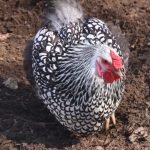
Country of Origin: Spain
Use: Dual-purpose; eggs, and meat
Weight Male: 4-4.5 kg
Weight Female: 2.5-2.7 kg
Skin Color: Yellow
Egg Color: Burnt Cream
The Pita Pinta Asturiana is a unique Spanish breed of chicken originating from the Asturias region in northwestern Spain. Its name is derived from the Asturian language, where “pita” means “hen” and “pinta” means “painted” or “mottled.”
This breed belongs to the Atlantic branch of domestic chickens and shares common origins with other chicken breeds in northern Spain. Unfortunately, due to the industrialization of egg production in the 1950s and 1960s, the Pita Pinta’s numbers drastically declined, almost reaching the brink of extinction. However, efforts to recover the breed began in the 1980s and 1990s, leading to the establishment of a breeders’ association and a herd book in the early 2000s.
The Pita Pinta is a compact, medium-weight chicken, with cocks weighing about 4-4.5 kg and hens around 2.5-3 kg. They have a single comb with 5 to 7 points and red earlobes, while their eyes are orange. The skin is yellow, and the beak and legs have yellow coloration with black spots. There are four color varieties: Pinta Negra (mottled black), Pinta Roxa (mottled red-brown), Blanca (white), and Abedul (black). The Pinta Negra variety is particularly distinguished by its black feathers edged with white, giving it a characteristic mottled appearance.
These chickens are valued for their egg-laying abilities, with hens being good and consistent layers. The eggs they produce have a unique color, resembling burnt cream, and weigh around 60-65 grams (approximately 2 ounces).
The preservation and revival of the Pita Pinta Asturiana breed demonstrate the importance of conserving indigenous chicken breeds and their cultural significance in their regions of origin.
Campine

Country of Origin: Belgium
Use: Eggs, Show
Weight Male: 2.5-2.7 kg
Weight Female: 2.0-2.3 kg
Skin Color: Yellow
Egg Color: White
The Campine is a domestic chicken breed originating from the Campine region in north-eastern Belgium and south-eastern Netherlands. Originally a smaller type of the Braekel, the Campine was established as a separate breed in 1904. However, in 1925 or 1926, it was reunited with the Braekel under the name Kempisch-Braekel. In 1962, the Campine type was considered extinct, and the breed’s name was changed to Brakelhoen.
The Campine was imported to England around 1899, where it underwent significant breeding changes, particularly in the cocks, which started to exhibit hen feathering. Birds were then exported to the United States, where they gained popularity and were added to the American Poultry Association’s Standard of Perfection in 1914.
The Campine comes in two color varieties: Silver and Gold. Both varieties have the same color pattern, but the Silver has a white head and neck hackles, while the Golden variety has a rich gold head and neck hackles.
In their country of origin, Campines were known for being “everyday layers,” reliably producing large white eggs. Nowadays, the breed is mostly kept for showing, and they are considered a flighty and hardy breed with an active and inquisitive nature.
As one of the rarest domestic chicken breeds, the Campine remains a unique and sought-after addition to poultry enthusiasts and exhibitions. While it lays a fair number of white-shelled eggs, its value lies predominantly in its ornamental qualities and historical significance.
Catalana

Country of Origin: Spain
Use: Dual-purpose; eggs, and meat
Weight Male: 3.2-3.7 kg
Weight Female: 2.3-2.7 kg
Skin Color: Yellow
Egg Color: Pinkish Cream
The Catalana, also known as Pota Blava, Gallina del Prat, or Catalana del Prat, is a Spanish breed of domestic chicken originating from the El Prat de Llobregat area in Catalonia, eastern Spain. It is sometimes referred to as Catalana del Prat Leonada or Buff Catalana due to its golden plumage. This hardy dual-purpose breed is valued for both its egg-laying capabilities and meat quality.
With its origins in Catalonia, Catalana has a long history and has been recognized internationally. It was included in the Standard of Perfection of the American Poultry Association in 1949, gaining recognition and popularity beyond its native Spain.
This breed is appreciated for its resilience, making it suitable for various environments and climates. As a dual-purpose chicken, it provides a consistent supply of eggs and meat, making it a valuable addition to farms and poultry enthusiasts alike. The beautiful golden plumage of the Catalana adds to its appeal, making it a breed cherished for both its utility and appearance.
Easter Egger

Country of Origin: American
Use: Eggs and Pets
Weight Male: 4-4.5 kg
Weight Female: 2.5-2.7 kg
Skin Color: Yellow
Egg Color: Varies
In American usage, an Easter egger or Easter-egger refers to hybrid or mixed-breed chickens resulting from breeding a bird with the blue-egg gene with one that lays brown eggs. As a result of this crossbreeding, the eggs produced by Easter eggers can vary in color, ranging from shades of blue or brown to occasional pink or pale yellow.
Easter eggers are not recognized as a distinct breed by the American Poultry Association or the American Bantam Association, as they do not have consistent physical characteristics. They may be marketed as “Americana,” but it is essential to note that they are different from the Ameraucana, a recognized breed.
These hybrid birds can exhibit a variety of colors, often having muffs and beards, with a pea-comb, and sometimes having small or absent wattles. Their legs may appear grey, yellow, or greenish. Due to crossbreeding, Easter eggers do not have fixed egg or body colors, making them visually diverse.
Easter eggers are mainly valued for their egg-laying abilities, as they produce eggs of varying colors, adding novelty to egg collections. While not considered suitable for meat production, they are known for their friendly temperament, making them good pets, especially around children. As a result of their unique egg colors and charming personalities, Easter eggers have become popular choices among backyard chicken keepers and poultry enthusiasts.
Egyptian Fayoumi
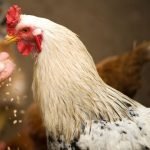
Country of Origin: Egypt
Use: Eggs
Weight Male: 1.35-1.8 kg
Weight Female: 0.9-1.6 kg
Skin Color: State Blue
Egg Color: White or Cream
The Fayoumi, also known as the Egyptian Fayoumi, is a breed of chicken originating from the governorate of Fayoum in Egypt. It is believed to be an ancient breed with a long history in the region.
In the 1940s, some Fayoumi eggs were imported from Egypt to the United States for experimental cross-breeding with American chickens. The intent was to explore the possibility of greater resistance to bacterial and viral infections in Egyptian birds. However, the Fayoumi is not recognized by the American Poultry Association and is not included in its Standard of Perfection.
The Fayoumi was first imported to the United Kingdom in 1984, where two color varieties are recognized: silver-penciled and gold-penciled. The plumage of the Fayoumi shows a resemblance to that of the Belgian Braekel.
This breed is characterized by its single comb with even serrations, bright red comb, earlobes, wattles, and dark brown eyes. Two color varieties, silver-penciled and gold-penciled, exhibit different patterns on the plumage, similar to the Belgian Braekel.
The Fayoumi is known for its hardiness and suitability for hot climates, making it well-adapted to free-range management. Hens are good layers of small white or cream eggs and tend not to be broody as pullets, but may become broody when they reach two or three years of age. The breed matures quickly, with hens laying eggs by around four and a half months and cockerels crowing at five or six weeks.
Overall, the Fayoumi remains a valuable and adaptable breed, treasured for its historical significance, foraging abilities, and reliable egg-laying capabilities, especially in hot climates.
Norwegian Jærhøne
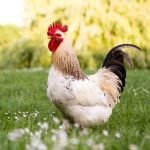
Country of Origin: Norway
Use: Eggs
Weight Male: about 1.7 kg
Weight Female: about 1.7 kg
Skin Color: Yellow
Egg Color: White
The Jærhøns (pronounced “yeah-her-ns”) or Norske Jærhøns is the only indigenous breed of domestic chicken in Norway. Its name is derived from the traditional district of Jæren in the county of Rogaland.
The Jærhøns was the primary chicken breed in Norway until the introduction of foreign breeds in the 19th century. It was selectively bred at the state-controlled breeding station in Bryne, Jæren, from 1916 until its closure in 1973. The breeding stock was then moved to the state agricultural college at Hvam, Nes. The Jærhøns is auto-sexing, a feature achieved through work done in the first half of the 20th century.
This breed of chicken was recognized as a “conservation-worthy national breed” in Norway, according to the Norwegian Forest and Landscape Institute’s action plan for the conservation and sustainable use of animal genetic resources (2008-2010).
The Jærhøns comes in two color varieties: dark brown and yellow, and light brown and yellow. It has a single comb and a bright yellow beak and legs. A bantam variety of the Jærhøns with the same two color options was approved in 1994.
As a laying breed, the Jærhøns produces around 215 eggs per year, which is slightly lower than industrial purpose-bred layers. The eggs are white and have a minimum weight of 55 grams.
Being the only indigenous chicken breed in Norway, the Jærhøns hold cultural significance and remain an important part of the country’s poultry heritage. It’s auto-sexing characteristics and traditional value contribute to its conservation as a breed worthy of preservation.
Twents Hoen

Country of Origin: Germany
Use: Eggs or Show Bird
Weight Male: about 2.75 kg
Weight Female: about 1.8 kg
Skin Color: Yellow
Egg Color: Off-White
The Kraienkopp, also known as Twents Hoen in Dutch, is a breed of chicken originating from the border region between Germany and the Netherlands. The breed was developed in the late 19th century through crosses of local chicken types with Malays and later with silver ducking Leghorns. It was first exhibited in the Netherlands in 1920 and in Germany in 1925.
The Kraienkopp comes in various color varieties, including silver, gold, orange/lemon, blue-gold, crele, pile, blue-silver, cuckoo, and silver cuckoo. In the United Kingdom, these color varieties are recognized. Males weigh around 2.75 kilograms (6 pounds), while females weigh approximately 1.8 kilograms (4 pounds). They have yellow skin and a small walnut-type comb.
Due to its rarity, the Kraienkopp is usually kept for egg-laying purposes or as a show bird. Hens lay a fair number of off-white eggs and are known to go broody. The breed is active and possesses excellent foraging abilities, making it well-suited for free-range management.
As a result of its historical background and unique color variations, the Kraienkopp is cherished by poultry enthusiasts and breeders alike. However, its scarcity means that efforts are being made to preserve and promote this distinctive breed.
Lakenvelder

Country of Origin: Germany
Use: Eggs
Weight Male: up to 2.5 kg
Weight Female: up to 2 kg
Skin Color: White
Egg Color: White to tinted
The Lakenvelder, pronounced /ˈlɑːkənvɛldər/, is a domestic chicken breed that originated in the Nordrhein-Westfalen area of Germany and neighboring regions of the Netherlands. It was first recorded in 1727, but its exact origins are still unclear, with two different proposed histories.
One account suggests that the Lakenvelder may have originated in Holland, where it was documented from 1727, and its name could be linked to the village of Lakerveld in South Holland. Another theory states that it might have originated in Germany, specifically in the area of Dielingen in Nordrhein-Westfalen, where black-and-white chickens were selectively bred as sports of the local Westfälischer Totleger breed.
The Lakenvelder’s popularity declined in the late 19th century when more productive imported breeds like the Leghorn were introduced. However, efforts to preserve the breed were made, and a breeders’ association, the Vereinigung der Lakenfelder Züchter, was formed in Germany in 1907.
The Lakenvelder is known for its distinct appearance. The head, neck hackle, and tail are solid black, while the rest of the bird is white with a pale blue-grey under-color. The striking black-and-white pattern resembles the coloring of the Lakenvelder breed of cattle, which also originated in the same area.
Characterized by bright chestnut or red eyes, a dark horn beak, a bright red face, wattles, and a comb with white earlobes, the Lakenvelder presents a unique and attractive appearance. The legs of this breed are slate-blue.
The Lakenvelder was imported to Britain in 1901 and introduced to the United States in 1939, where it gained recognition from the American Poultry Association. Despite its historical significance, the Lakenvelder is considered an extremely endangered breed in Germany, with efforts being made to conserve and protect it for future generations.
Leghorn
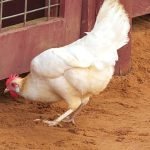
Country of Origin: Central Italy
Use: Eggs
Weight Male: 2.4-3.4 kg
Weight Female: 2.0-2.5 kg
Skin Color: Yellow
Egg Color: White
The Leghorn, also known as Livorno or Livornese, is a breed of domestic chicken originating from Tuscany, Italy. It derives from light breeds found in rural Tuscany, and its name is derived from Leghorn, the anglicization of Livorno, the port from which the first birds were exported to North America in 1828 or around 1830.
Originally known as “Italians,” they were later referred to as “Leghorns” in 1865 in Worcester, Massachusetts. The Leghorn was included in the American Standard of Perfection in 1874, and various color varieties have been recognized since then, including black, white, brown (light and dark), buff, silver, golden duckwing, and more.
The breed was introduced to Britain from the United States in 1870, and from there, re-exported to Italy. Leghorns are known for their small size, weighing around 1.6 kg, but their weight was increased through cross-breeding with other breeds.
In Italy, ten color varieties are recognized, while the Fédération française des volailles divides them into four types: American white, English white, old type (golden salmon), and modern type. The Leghorn is most commonly known for its excellent egg-laying capabilities, producing around 280 white eggs per year, and sometimes up to 300-320 eggs, each weighing at least 55g.
White Leghorns have been widely used to create highly productive egg-laying hybrids for commercial and industrial purposes. They are valued for their efficient egg production and are popular in many countries as layer chickens.
Minorca
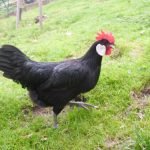
Country of Origin: Spain
Use: Eggs
Weight Male: 3.2-3.6 kg
Weight Female: 2.7-3.6 kg
Skin Color: White
Egg Color: White
The Minorca, also known as Gallina de Menorca in Catalan or Menorquina in Spanish, is a breed of domestic chicken originating from the Mediterranean island of Menorca in the Balearic Islands, located southeast of Spain. The breed is well-known as an exhibition bird in many countries around the world, but unfortunately, it is considered endangered and at risk of extinction on its native island of Menorca.
The international type of the Minorca was developed by the British from native Menorcan chickens during their occupation of the island from 1708 to 1783. The breeding process is believed to have started in Menorca and continued in Britain, where imports of chickens from Menorca are documented in the 1780s. The breed was highly regarded as an egg-laying breed in Devon and Cornwall in England, and it was exhibited in Paris under the name “Barbezieux.” By the late 1800s, the Minorca had spread to Germany and was recognized by the American Poultry Association in 1888.
In recent times, the Minorca was relatively uncommon on its native island, and a conservation and improvement program was initiated in 2012 by the Associació de Gallines Menorquines, an association of breeders in Menorca. The breed is listed as at risk of extinction by the Spanish Ministry of Agriculture, and the population in Spain was reported to be 460 birds at the end of 2012.
The Minorca is a medium-sized breed with glossy greenish-black plumage. Cocks weigh about 2.8 kg, and hens weigh around 2.2 kg. They have a sloping back and a nearly horizontal tail. The comb, face, and wattles are bright red, and the comb is single with six well-defined points. The wattles are large and smooth, and the earlobes are white and almond-shaped. The skin is white, and the legs are black or dark slate-colored. There are different color varieties of Minorcas, including blue, white, buff, and barred, depending on the country’s recognized standards.
The Minorca is known for its egg-laying capabilities. Hens start laying early, at around 26 weeks and can produce approximately 120 white eggs per year. The eggs weigh over 65 grams from the 57th week of the hen’s life.
Despite being endangered on its native island, the Minorca remains a popular ornamental breed and is valued for its unique appearance and egg-laying qualities. Efforts are being made to conserve and improve the breed’s population to ensure its survival.
Orloff

Country of Origin: Persia, Russia
Use: Eggs
Weight Male: about 3.6 kg
Weight Female: about 3.0 kg
Skin Color: Yellow
Egg Color: Light Brown
The Orloff is a breed of chicken named after Count Alexei Grigoryevich Orlov, a Russian nobleman. While it was originally believed to be a product of Russia and Orlov, modern research has revealed that the breed first appeared in Persia and was distributed across Europe and Asia by the 17th century. However, Count Orlov played a significant role in promoting the breed in the 19th century, leading to its association with his name.
The first Orloff chickens were imported to Central Europe from the Russian Empire in 1884. They were also known as “Orloff fighters” due to their historical use in cockfighting. The breed was introduced to Great Britain in the 1920s and was refined in Germany, where the first miniaturized bantam Orloff was created in 1925. Despite being included in the American Poultry Association’s breed standard at one point, it was later removed due to a lack of interest from breeders. As a result, the Orloff remains a rare breed in the Western world, and it is listed as critically endangered by the Livestock Conservancy.
The Orloff is characterized by its tall and well-feathered appearance, giving it a somewhat game-like look. The head and neck are heavily feathered, and they come in various recognized color varieties such as Black, White, Spangled, Black-tailed Red, Mahogany, and Cuckoo. With their small walnut comb, tiny earlobes, and minimal wattles, Orloffs are well-adapted to cold weather. Males typically weigh around 3.6 kilograms (7.9 lb), while hens weigh about 3 kg (6.6 lb). While Orloffs are mainly raised for meat production, hens also lay light brown eggs and are not known for being broody. In terms of temperament, they are generally calm birds. Due to their endangered status, efforts are being made to preserve and protect the Orloff breed.
Penedesenca

Country of Origin: Spain
Use: Eggs
Weight Male: 2.3-3.0 kg
Weight Female: 1.7-2.3 kg
Skin Color: Yellow
Egg Color: Dark Reddish-Brown
The Penedesenca is a Spanish breed of chicken that originated in the Catalonia region, specifically around Vilafranca del Penedès, the main town of the historical Penedès area.
The breed’s history is not well-documented, and it is uncertain how long the local people in Catalonia had been raising chickens that laid dark brown eggs. The first recorded mention of the breed dates back to 1928 when efforts were made to prevent its extinction. In 1932, a group of breeders near Vilafranca del Penedès began selecting a black variety of the Penedesenca chicken. A breed standard for this black Penedesenca called “Villafranquina Negra” or black Vilafranca chicken, was established in 1946.
The Penedesenca was developed in the early 20th century from native barnyard chickens in the region. It is known for its distinctively dark brown eggs, which are considered among the darkest of any chicken breed. Today, the Penedesenca is appreciated for its unique egg color and is raised for its dual-purpose capabilities, as it can be used for both egg production and meat.
While the breed has a local significance in Catalonia, it remains relatively rare in other parts of the world. Efforts are being made to preserve and promote this breed, especially for its ability to produce highly prized dark brown eggs.
Sicilian Buttercup
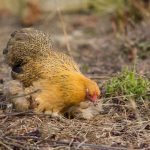
Country of Origin: Sicily, Italy
Use: Eggs
Weight Male: about 2.95 kg
Weight Female: about 2.50 kg
Skin Color: Yellow
Egg Color: White
The Sicilian Buttercup is a breed of domestic chicken that originated from the island of Sicily. It was brought to the United States in the 19th century and later imported to Britain and Australia in the early 20th century. The breed is believed to have derived from the indigenous Siciliana breed of Sicily, but over time, it has developed distinct characteristics due to separation from the original stock.
The Siciliana breed is thought to have been created through inter-breeding of local Sicilian chickens with North African stock, possibly including breeds like the rose-combed Berbera or Tripolitana. Depictions of similar chickens can be found in paintings from the 16th century in Rome, Florence, Paris, and the Vatican Museums.
In the 1860s or 1870s, Cephas Dawes of Dedham, Massachusetts, purchased chickens from Sicily while loading oranges for his journey back home. Some of these chickens continued to lay eggs during the voyage and were kept for that purpose. C. Carroll Loring, another resident of Dedham, acquired some of these chickens from Dawes and became the first breeder of what would later be known as the Sicilian Buttercup. However, all American Buttercups today are descendants of a later shipment of hatchlings in 1892.
In 1912, the American Buttercup Club was formed in the United States, and by 1914, it had 600 members. A similar association was established in Britain in 1913. The Sicilian Buttercup was included in the Standard of Perfection of the American Poultry Association in 1918. However, the breed is currently listed as “threatened” by the American Livestock Conservancy and is on the “Rare and Native Breeds” list of the British Rare Breeds Survival Trust.
White-Faced Black Spanish

Country of Origin: Spain
Use: Eggs
Weight Male: 2.5-3.0 kg
Weight Female: 2.0-2.5 kg
Skin Color: White
Egg Color: White
The Spanish, also known as the White-faced Black Spanish or Española Cara Blanca, is a breed of domestic chicken that originated in Spain. However, it was primarily developed into its present type in Great Britain during the eighteenth century. Despite its name, it is now rare in Spain but can be found distributed throughout the world.
The Spanish chicken has glossy black plumage and is closely related to the Minorca and Castellana Negra breeds. Its most distinguishing feature is its white, low-hanging earlobes, which are overdeveloped. The breed has a single comb, four toes, and no crest.
Spanish hens are known as non-sitters, meaning they do not have a strong inclination to go broody and hatch eggs. Instead, they are prolific layers of white eggs, producing approximately 160 to 180 eggs per year. The eggs typically weigh around 80 grams.
The breed was recognized and admitted into the American Poultry Association in 1874, which further contributed to its popularity and distribution in various regions around the world.
Welsummer
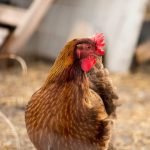
Country of Origin: Netherlands
Use: Dual-Purpose; Eggs and Meat
Weight Male: 2.75-3.25 kg
Weight Female: 2.0-2.5 kg
Skin Color: Cream
Egg Color: Dark Brown
The Welsummer, also known as Welsumer, is a Dutch breed of domestic chicken that originated in the village of Welsum in the eastern Netherlands. It was developed at the beginning of the twentieth century through crossbreeding local fowls of various origins, including Rhode Island Reds, Barnevelders, Partridge Leghorns, Cochins, and Wyandottes. Over time, a standard was established for the breed, leading to a good level of uniformity among the birds.
The Welsumer’s primary use was originally for the commercial egg trade, with its dark brown eggs being exported. The breed’s popularity spread to the United Kingdom, where it was added to the British Standard in 1930.
Three plumage colors are recognized for the Welsumer by the Entente Européenne d’Aviculture et de Cuniculture, but in the Netherlands, only the Red Partridge color is officially recognized.
As for its egg-laying capabilities, Welsumer hens are known to lay approximately 160 eggs per year. These eggs are dark brown and have an average weight of about 65 grams. In the case of Bantam Welsumers, a smaller variety of the breed, they lay around 180 dark brown eggs per year, with an average weight of 47 grams.
In the past, some Welsumer flocks in the Netherlands were affected by the outbreak of foot-and-mouth disease in 2001, resulting in the culling of these birds on certain farms. However, the breed continues to be valued for its attractive appearance and productive egg-laying abilities.
Meat
The majority of farms and homesteads opt for dual-purpose breeds to fulfill their meat production needs. Additionally, there are specific breeds dedicated primarily to meat production:
Bresse

Country of Origin: France
Use: Meat
Weight:
1.2 kg pullets
1.8-3.0 kg large hens
Skin Color: White
Egg Color: White
The poulet de Bresse, also known as volaille de Bresse, is a highly esteemed French chicken product with appellation d’origine contrôlée (AOC) status and is also recognized as a Protected Designation of Origin (PDO) under EU and UK law. It can only be produced from white chickens of the Bresse Gauloise breed raised within a legally-defined area in the historic region of Bresse, located in eastern France.
The chickens of the Bresse region have had a renowned reputation for their quality for a long time. The name Volaille de Bresse, which includes chicken and turkey products, received legal protection in 1936 and was later granted AOC status in 1957. Today, poulet de Bresse is considered one of the finest table chickens globally, earning it the nickname “queen of poultry, poultry of kings” by gastronome Jean Anthelme Brillat-Savarin.
The production of poulet de Bresse is strictly regulated. The chickens must be of the Bresse de Bény variety and raised in a specific area encompassing parts of the Ain, Jura, and Saône-et-Loire départements in the regions of Rhône-Alpes, Franche-Comté, and Bourgogne. The birds are raised under meticulous control, and each breeder must have a minimum amount of pasture for their birds.
The chickens are raised free-range for at least four months and are fed a diet intentionally low in protein to encourage natural foraging behavior. Later, they are finished in a fattening shed and intensively fed on maize and milk. The birds are marketed with their characteristic slate-blue legs and metal leg rings with the name of the producer.
Poulet de Bresse commands premium prices due to its quality and unique production methods. Producers receive higher prices compared to standard and organic chickens, making it a highly sought-after and valuable product in the market.
Cornish, or Indian Game
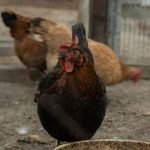
Country of Origin: United Kingdom
Use: Meat
Weight Male: 3.6 kg standard
Weight Female: 2.7 kg standard
Skin Color: Yellow
Egg Color: Light Brown
The Indian Game is a British breed of game chicken that originated in the early nineteenth century in Cornwall and Devon, in southwest England. It was initially intended to be a gamecock for cockfighting, but it did not excel in this role. Instead, it was found to be a good meat breed due to its heavy and muscular build, particularly its broad breast.
In the United States, the name of the breed was changed to “Cornish” in the early twentieth century. At around the same time, a white variant known as the White Cornish was developed and is now widely used in modern industrial chicken meat production for cross-breeding to produce hybrid broilers or fast-growing “game hens.”
The Indian Game is a large and stocky bird with short legs and an exceptionally broad and deep breast. It comes in different color variants, such as dark, Jubilee, double-laced blue, white, white-laced red, and buff, depending on the country and recognized standards.
While resistant to most common poultry diseases, Indian Game chickens are vulnerable to parasites. They have thin and hard feathers without down, which can make them susceptible to cold weather and may delay breeding in early Spring.
The breed is valued for its meat production, and it has been used for cross-breeding with other meat breeds like Dorking, Orpington, and Sussex. However, it is not known for its egg-laying capabilities, with hens laying about 80 small and light brown eggs per year.
Ixworth

Country of Origin: United Kingdom
Use: Meat
Weight Male: 3.6-1.4 kg
Weight Female: 2.7-3.2 kg
Skin Color: White
Egg Color: Tinted
The Ixworth is a white domestic chicken breed originating from the village of Ixworth in Suffolk, England. It was created in 1932 by Reginald Appleyard, who also developed the Silver Appleyard Duck. The breed was carefully bred using white Sussex, white Minorca, white Orpington, Jubilee, Indian Game, and white Indian Game chickens. The aim was to create a dual-purpose bird, focusing on fast growth for high-quality meat and reasonable egg-laying ability.
During the 1970s, the Ixworth faced a significant decline, and it became an endangered breed. However, efforts to preserve it have gradually helped it recover, though it remains rare. In 2007, it was listed as “endangered-maintained” by the FAO, and in 2008, it was classified as “Category 2: endangered” by the Rare Breeds Survival Trust. As of 2014, it was still considered at risk on the Trust’s list of native poultry breeds.
The Ixworth is known for its pure white plumage, bright red pea-type comb, face, earlobes, wattles, and orange or red eyes. The beak, shanks, feet, skin, and flesh are all white as well.
In a comparative study conducted at the Roslin Institute in 2003, Ixworth hens were found to reach a live weight of around 4.03 kg (8.9 lb) at 55 weeks of age and produce an average of 0.74 eggs per day, with each egg weighing approximately 61.0 grams.
Due to its meat quality and rarity, the Ixworth breed commands premium prices. Efforts to protect and promote this unique breed continue to ensure its survival and recognition in the poultry community.
Dual-purpose
Throughout barnyards across the globe, the prevalent breeds are versatile utility birds that excel in both meat and egg production. While some may exhibit slightly higher proficiency in one of these aspects, they are commonly referred to as dual-purpose breeds. These adaptable birds offer a valuable combination of meat and egg productivity.
Barnevelder

Country of Origin: Netherlands
Use: Dual Purpose; Eggs and Meat
Weight Male: 3-3.5 kg
Weight Female: 2.5-2.75 kg
Skin Color: Yellow
Egg Color: Brown
The Barnevelder is a Dutch breed of domestic chicken that was developed through cross-breeding between local Dutch chickens and “Shanghai” birds imported from Asia in the late 19th century. The breed is named after the town of Barneveld in the central Netherlands, where the cross-breeding took place. It is a hardy and popular breed known for its ability to lay large brown eggs consistently, even during the winter months.
The history of the Barnevelder involves cross-breeding with various Asian chickens, including Brahma, Cochin, and Croad Langshan types, along with possible influences from Amerikaanse Nuthoenders and Buff Orpington stocks. The breed was first shown at an agricultural exhibition in The Hague in 1911, and efforts to standardize its type and color began around that time. The Barnevelder was officially recognized as a breed in 1923.
Several color varieties are recognized in both large fowl and bantam Barnevelders, including double-laced, double-laced blue, black, and white. Additional colors, such as blue and partridge, are recognized by the Entente Européenne in large fowl, and crele and partridge are recognized in bantams. In the United Kingdom, the recognized varieties include double-laced blue, double-laced brown, double-laced silver, and black.
Barnevelder hens are productive layers, laying approximately 175-200 brown eggs per year, with each egg weighing around 60-65 grams. The breed’s reputation for consistent egg production and hardiness has made it a popular choice for poultry keepers worldwide.
Brahma

Country of Origin: United States
Use: Dual Purpose; Eggs and Meat
Weight Male: about 5.5 kg
Weight Female: about 4.5 kg
Skin Color: Yellow
Egg Color: Brown
The Brahma is an American breed of chicken that was developed in the United States from birds imported from the Chinese port of Shanghai. These large birds with heavily feathered legs, known as “Shanghai” birds, were imported in the 1840s. The Brahma likely resulted from cross-breeding with Grey Chittagong birds of Malay type, which were imported from Chittagong in eastern Bengal (now Bangladesh). This cross-breeding gave the Brahma its distinctive head shape and pea comb, distinguishing it from the Cochin breed, which also descended from “Shanghai” birds.
Initially, the breed had various strains and names, but it was eventually named “Brahmapootra” at a poultry judges’ meeting in Boston in 1852, later shortened to “Brahma.” The breed was first exported to England in 1852, and the Dark Brahma variety was developed there and re-exported to the United States.
The Brahma became the principal meat breed in the United States from the 1850s until around 1930. Some individuals were exceptionally large, with recorded weights of about 8 kg (18 lb) for cocks and 6 kg (13 lb) for hens.
The Brahma comes in three color varieties recognized by the American Standard of Perfection: light, dark, and buff. The light variety has a white base color with black hackles edged in white and a black tail. The dark variety has a dark gray and black penciled coloration in hens, and black and white hackles and saddle feathers in cocks. The buff variety has the same black pattern as the light but with a golden buff base color.
The breed’s weight typically averages about 5.5 kg (12 lb) for cocks and 4.5 kg (10 lb) for hens. Brahma chickens are known for being good winter layers of large brown eggs, weighing approximately 55–60 g each.
Overall, the Brahma has a rich history and continues to be appreciated for its size, distinctive appearance, and egg-laying abilities.
Braekel or Brakel

Country of Origin: Belgium
Use: Dual Purpose; Eggs and Meat
Weight Male: 2.0-2.5 kg
Weight Female: 1.8-2.2 kg
Skin Color: White
Egg Color: White
The Braekel, also known as Brakel, is a traditional Belgian breed of chicken that is believed to have originated in the area of Brakel, in the Flemish province of East Flanders, for which it is named. It is part of the same extended population of gold and silver chickens that gave rise to other closely related breeds like the Ostfriesische Möwe and Westfälischer Totleger.
The Braekel breed was recognized in two distinct types in 1884: the larger Braekel of Flanders and a smaller, lighter type from the Campine region to the east. However, in 1926, the separate Braekel and Campine breeds were brought together under a single breed standard. It is worth noting that the Campine breed in the United Kingdom is different from the Braekel breed, likely resulting from cross-breeding with pencilled Hamburgs. One principal difference is that cock birds in the UK Campine breed display hen-feathering, which is not seen in the Belgian Braekel type.
The Braekel is a light breed, with standard-sized cocks weighing around 2-2.5 kg and hens weighing 1.8-2.2 kg. The bantam version of the Braekel is smaller, with cocks weighing approximately 800 g and hens around 700 g.
The breed is known for its straight banding pattern of feathers and a uniform solid neck color, and it comes in various color variants, with gold and silver being the most common. Braekel hens are good layers, starting to produce eggs at around six or seven months of age. In a year, they can lay approximately 180 white-shelled eggs, each weighing about 60-65 g.
Due to a decline in population during and after the Second World War, the Braekel is now considered a rare breed. Efforts are being made to preserve and protect this traditional Belgian chicken breed.
Buckeye

Country of Origin: United States
Use: Dual Purpose; Eggs and Meat
Weight Male: about 4.0 kg
Weight Female: about 3.0 kg
Skin Color: Yellow
Egg Color: Brown
The Buckeye is an American breed of chicken that was created in Ohio in the late nineteenth century by Nettie Metcalf. It is a dual-purpose chicken, meaning it is kept for both meat and egg production. The Buckeye is named after the Ohio Buckeye plant, and its plumage color was intentionally bred to resemble the color of the plant’s seeds, hence why Ohio is called the ‘Buckeye State’.
Nettie Metcalf crossbred Barred Plymouth Rocks, Buff Cochins, and some black-breasted red games to develop the Buckeye breed. Her goal was to create a functional breed that could thrive in the harsh winters of the Midwest. The Buckeye was developed before the Rhode Island Red breed, and interestingly, Metcalf sent birds to Rhode Island Red breeders to help improve their breed.
The Buckeye was officially recognized by the American Poultry Association’s Standard of Perfection in 1904. This recognition allowed Buckeyes to be entered into poultry shows and judged according to the breed standard. While the Buckeye hasn’t been very popular in exhibition poultry shows due to its lack of color variations, there has been growing interest in the breed for its dual-purpose qualities.
Today, the Buckeye breed is listed as “watch” by the American Livestock Breeds Conservancy, meaning there are fewer than 5,000 breeding birds in the United States and the estimated global population is less than 10,000. The breed is included in the Slow Food USA Ark of Taste, which catalogs heritage foods at risk of extinction.
Characteristics of the Buckeye breed include a medium to large size, with males weighing around 9 lbs (4 kg) and hens weighing around 6.5 lbs (3 kg). They have yellow skin and lay brown eggs. The primary color of the Buckeye is a mahogany red with black tails, and their plumage is intended to resemble the hue of an Ohio Buckeye’s seeds. The breed has a pea comb, which is unique among purely American chicken breeds. Buckeyes are known for their cold-hardiness, compact build, and good foraging abilities. They are generally calm but can become aggressive in rare cases. Buckeyes are good meat producers and lay between 150 and 200 eggs per year, making them well-suited for small farmyard and backyard flocks.
California Gray
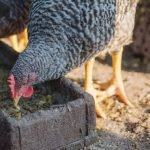
Country of Origin: United States
Use: Dual Purpose; Eggs and Meat
Weight Male: about 2.5 kg
Weight Female: about 2.0 kg
Skin Color: White
Egg Color: White
The California Gray is an American breed of domestic chicken, also known as the “production black.” It was developed in California in the 1930s by Horace Dryden in Modesto, California. Dryden’s goal was to create a dual-purpose chicken that would be suitable for meat production and also lay large white eggs.
The California Gray was created through cross-breeding Barred Plymouth Rock and White Leghorn birds, resulting in an autosexing breed with barred gray adult plumage. Autosexing breeds allow the sex of chicks to be distinguished at about a day old, which is useful for poultry farmers.
Although the California Gray was never officially recognized as a breed by the American Poultry Association, it was a successful creation and served its purpose as a dual-purpose bird. It is not widely recognized in the modern poultry industry and is considered a rare breed. As such, it is not listed on the conservation priority list of the Livestock Conservancy, and it is not reported in the DAD-IS database of the FAO.
The California Gray is utilized for both meat and egg production. In commercial settings, male California Gray chickens are often crossed with White Leghorn hens to produce the California White commercial sex-link hybrid, which is widely used in the poultry industry.
Chantecler

Country of Origin: Canada
Use: Dual Purpose; Eggs and Meat
Weight Male: about 4.1 kg
Weight Female: 2.9-3.4 kg
Skin Color: Yellow
Egg Color: Brown
The Chantecler is a breed of chicken originating in Canada, specifically developed at the Abbey of Notre-Dame du Lac in Oka, Quebec, in the early 20th century. Brother Wilfrid Châtelain, a Trappist monk and Doctor of Agronomy, aimed to create a practical chicken that would be well-suited to Canada’s climate and production needs.
The White Chantecler, the original variant, was created by combining Dark Cornishes, White Leghorns, Rhode Island Reds, White Plymouth Rocks, and White Wyandottes. It was admitted into the American Poultry Association’s Standard of Perfection in 1921. The breed was primarily bred for its white color, which is preferred for commercial meat production due to the clean-looking carcass it produces.
In the 1930s, the Partridge Chantecler was developed by crossing Partridge Wyandottes, Partridge Cochins, Dark Cornishes, and the rose comb type of Brown Leghorns. This variant was more adapted to free-range conditions and was admitted to the Standard in 1935. Additionally, a Buff variety has been present since the 1950s, but it has not been admitted to show standards.
The Chantecler faced extinction in the late 1970s, but a few small farms continued to maintain the breed. In the 21st century, the Chantecler is still in existence but is considered a critically endangered breed by the American Livestock Breeds Conservancy.
Characteristics of the Chantecler include its large size, respectable egg-laying capabilities, and good meat production. Roosters weigh around 9 pounds (4.1 kg), while hens weigh between 6.5 and 7.5 pounds (2.9 to 3.4 kg). They have yellow skin and beaks and lay brown eggs. The breed is known for its cold hardiness, with plumage that lies tight against the body and an exceptionally small cushion comb and wattles. Chanteclers are generally gentle and can be tamed, but they may become temperamental in confinement.
Cubalaya
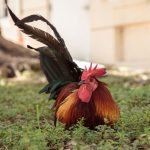
Country of Origin: Cuba
Use: Dual Purpose; Eggs and Meat
Weight Male: about 2.4 kg
Weight Female: about 1.5 kg
Skin Color: Yellow
Egg Color: Light Brown
The Cubalaya is a Cuban breed of domestic chicken known for its stately carriage, pea comb, and long, well-spread tail carried at about 20 degrees below the horizontal. It is the only chicken breed with official recognition from the Asociación Nacional de Avicultura, the Cuban National Poultry Association. The breed has a fascinating history that traces back to the middle 19th century when Spaniards brought several varieties of Asiatic game fowl from the Philippine Islands to Havana, Cuba.
The Cubans selectively crossed and re-crossed these Asiatic breeds with birds of European origin, aiming to create a triple-purpose breed for meat, eggs, and cock-fighting. They selectively bred the birds for specific traits, such as wide, extended tails, a curving beak, fierce eyes, and a courageous expression, giving rise to the Cubalaya.
In 1935, the Asociacion Nacional de Avicultura approved the Cubalaya breed’s recognition. The name “Cubalaya” was chosen in honor of the Republic of Cuba, which supported and refined the breed. The Cubalaya was introduced to the United States at the International Poultry Exhibition in 1939 and gained recognition from the American Poultry Association the same year. The bantam variety of the Cubalaya is recognized by the American Bantam Association.
The Cubalaya is characterized by its friendly and curious disposition, heat tolerance, and excellent foraging abilities when allowed to roam freely. The hens are known for laying small eggs and being good brooders. The breed comes in two sizes: standard and bantam. Standard-sized cocks weigh around 2.40 kg, and hens weigh about 1.59 kg. Bantam cocks weigh approximately 740 g, and hens weigh around 625 g.
The original Cuban standard allowed three colors: black, black-breasted red, and white. However, many other colors were bred in Cuba during that time. Currently, the American Poultry Association and the American Bantam Association recognize the same three colors for the Cubalaya breed.
Derbyshire Redcap
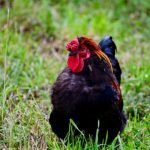
Country of Origin: United Kingdom
Use: Dual Purpose; Eggs and Meat
Weight Male: about 3.4 kg
Weight Female: about 2.75 kg
Skin Color: Blue-Grey
Egg Color: White
The Derbyshire Redcap is a breed of chicken that originated in the English county of Derbyshire. It is known for its unusually large Rose-type comb, which gives it the name “Redcap.” The comb should ideally be more than 7 centimeters (3 inches) in length, covered in small fleshy points, and have a distinct spike pointing backward called a “leader.” Redcaps are classified as light fowl, with cocks weighing around 3.4 kilograms (7.5 lb) and hens weighing approximately 2.75 kg (6.1 lb). They can be distinguished from similar-looking breeds like the Hamburgs by their red earlobes and larger comb.
The breed displays various dark hues of red, brown, and black in their plumage, with cocks showing a greater diversity of colors. Both males and females have black tails and a crescent shape of black on the edge of most body feathers.
Derbyshire Redcaps are hardy and active chickens that do well in free-range conditions. They are well-suited for dual-purpose farm flocks, as they are used for both meat and egg production in addition to their ornamental qualities. The hens typically lay a good amount of large, white-colored eggs, although they are not known for going broody.
The exact breeds that contributed to the creation of the Redcap are not fully known, but it is believed that Golden Spangled Hamburgs, Dorkings, Old English Pheasant Fowl, and Black-Breasted Red Games might have played a role. The breed was common on British farms until the middle of the 20th century, particularly around the southern Pennines. However, they have always been primarily barnyard fowl and were not preferred by intensive farms or commercial operations. As a result, the Derbyshire Redcap is now a very rare breed, with the largest numbers still residing in the UK. The Rare Breeds Survival Trust lists them as Vulnerable on their watch list, while in the United States, they are listed as Critical on the American Livestock Breeds Conservancy watchlist.
Dominique
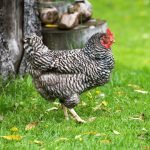
Country of Origin: United States
Use: Dual Purpose; Eggs and Meat
Weight Male: 2.7-3.2 kg
Weight Female: 1.8-2.3 kg
Skin Color: Yellow
Egg Color: Brown
The Dominique is an American breed of chicken known for its black-and-white barred plumage and rose comb. It is considered to be the oldest American chicken breed and is believed to have descended from birds brought to America by colonists from southern England. Chickens with barred plumage and single or rose combs were well-known by about 1750, and by the mid-nineteenth century, the Dominique was widely distributed in the eastern United States.
The breed has been known by various names, such as Blue Spotted Hen, Dominic, Dominicker, Dominico, Old Grey Hen, and Pilgrim Fowl, but it became commonly known as the Dominique. It was exhibited at the first American poultry show held in Boston in 1849.
In the 1860s, the Plymouth Rock breed was created by cross-breeding Black Java with large single-combed Dominiques. However, a ruling was made in 1870 that only rose-combed barred birds could be exhibited as Dominiques, while those with single combs were entered as Plymouth Rocks. In 1871, this ruling was confirmed in the Standard of Excellence for Dominique. The breed was officially recognized in the first edition of the American Standard of Perfection by the American Poultry Association in 1874.
During the 20th century, the Dominique breed declined in numbers and was close to disappearing by the 1970s. However, a conservation initiative was launched, leading to a recovery in numbers since 1983. The breed is now listed as “watch” by the Livestock Conservancy, indicating it is not at risk.
The Dominique is of medium size, with mature birds typically weighing 5-7 pounds (2.3-3.2 kg). The plumage coloration is cuckoo, a pattern of light and dark barring. The breed has a high head carriage, a rose comb with a single spike pointing backward, red earlobes and wattles, and yellow legs and feet.
The Dominique is a dual-purpose breed, commonly kept for its brown eggs. Hens lay approximately 200 eggs per year, each weighing around 58 grams. The breed is also known for its resistance to frostbite due to its tight plumage and rose comb.
Dorking
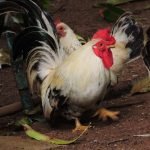
Country of Origin: United Kingdom
Use: Dual Purpose; Eggs and Meat
Weight Male: 3.60-6.35 kg
Weight Female: 3.60-4.55 kg
Skin Color: White
Egg Color: White or Tinted
The Dorking is a British breed of domestic chicken that is one of the oldest chicken breeds in the country. Its name comes from the town of Dorking in Surrey, England, where the breed was originally developed and from where birds were sent to the markets of London.
The Dorking breed has a long history and is sometimes suggested to have been brought to Britain by the Romans in the first century AD. Some historical records mention five-toed hens as being the best breeding stock, which could indicate that the Romans brought poultry with them, but the exact origin of the Dorking is not certain.
The Dorking was primarily known for its meat production and was the principal meat breed supplied to London until it was gradually replaced by the Sussex breed in the early 20th century. It was also popular as an exhibition bird and was shown at the first poultry show at London Zoo in 1845.
The breed has a rectangular body and short, five-toed legs. It is well-regarded for its versatility, being used for both egg and meat production. Dorkings are known for producing white-shelled eggs and have red earlobes. The skin color beneath their feathers is white.
There are five recognized color varieties of the Dorking breed: white, silver-grey, red, dark, and cuckoo. The weight of Dorkings varies between 4.55 and 6.35 kg (10 to 14 lb) for cocks, 3.60 to 5.00 kg (8 to 11 lb) for cockerels, and 3.60 to 4.55 kg (8 to 10 lb) for hens.
Interest in the Dorking breed waned over time, leading to a decline in numbers, and it drew close to extinction. However, the Dorking Club was restarted in 1970, contributing to the breed’s preservation. The breed was also recognized in the United States, with three color varieties and three bantam varieties included in the American Poultry Association’s Standard of Perfection.
Faverolles

Country of Origin: France
Use: Dual Purpose; Eggs and Meat
Weight Male: about 5.0 kg
Weight Female: about 4.3 kg
Skin Color: Yellow
Egg Color: Light Brown to Pinkish
The Faverolles is a French breed of chicken that was developed in the 1860s in the north-central region of France, near the villages of Houdan and Faverolles. The breed got its name from the latter village, and it is spelled “Faverolles,” not “Faverolle” – the final “s” is silent in French.
Originally, Faverolles were bred as utility fowl, serving both as egg-layers and meat birds. Over time, they have become primarily raised for exhibition purposes, although they still retain their excellent laying and meat-producing abilities.
Faverolles are classified as a heavy breed and are easily recognizable by their unique features, such as a beard, muffs (feathered cheeks), feathered feet, and an extra toe on each foot (five toes per foot instead of the usual four). They adapt well to both confinement and free-range environments.
The most common color variety is Salmon, with females having mainly brown and creamy white plumage, while males display darker feathers in shades of black, brown, and straw color. Other color varieties include white, black, ermine, cuckoo, mahogany, splash, and blue.
Faverolles are known for their docile and gentle nature, making them popular as pets, especially for families with children. They are also increasingly favored by small-scale poultry keepers for their dual-purpose qualities, excelling in both egg production and meat quality. They are considered to be good layers, with a well-cared-for hen laying around four eggs per week.
The weight of Faverolles varies depending on the region and breed standards. For example, British Faverolles cocks weigh around 9-11 lb (4-5 kg), hens weigh 7.5-9.5 lb (3.4-4.3 kg), while bantam cocks weigh 1130-1360 g, and hens 907-1133 g. The Australian and United States standards call for slightly smaller birds, but they are still relatively large chickens.
Faverolles are a charming and versatile breed, combining ornamental and productive qualities that make them well-loved by poultry enthusiasts around the world.
Holland
Country of Origin: United States
Use: Dual Purpose; Eggs and Meat
Weight Male: about 3.9 kg
Weight Female: about 3.0 kg
Skin Color: Yellow
Egg Color: White
Hollands are a relatively rare breed of large chickens that originate from America. They are considered a dual-purpose breed, meaning they are suitable for both egg-laying and meat production. Hollands are similar in appearance to Plymouth Rocks and Dominiques but can be distinguished by specific characteristics. For instance, Plymouth Rocks have colored feet, while Hollands have white feet, and Dominiques have a rose comb, whereas Hollands have a different comb type.
The breed was developed at the Rutgers Breeding Farms in New Jersey by crossing birds imported from Holland with White Leghorns, Rhode Island Reds, New Hampshires, Lamonas, Barred Plymouth Rocks, Australorps, and Brown Leghorns. These breeding efforts led to the creation of two main varieties of Hollands: White Hollands and Barred Hollands. Both varieties were accepted by the American Poultry Association in 1949.
Hollands are classified as part of the American class of chicken breeds. There are two main varieties: White and Barred. They are valued for their dual-purpose capabilities, producing both eggs and meat. The egg size is medium, and the egg color is white. Hollands have yellow skin, which is a common trait among many chicken breeds.
In terms of weight, the standard weights for adult Hollands are as follows: Cocks weigh around 8½ lbs (3.9 kg), Hens weigh approximately 6½ lbs (2.9 kg), Cockerels weigh about 7½ lbs (3.4 kg), and Pullets weigh around 5½ lbs (2.5 kg).
Additionally, there is also a bantam version of the Holland breed, which is a smaller, miniature version of the standard Hollands. Bantams are popular among poultry enthusiasts who have limited space or prefer smaller chickens.
Overall, Hollands are an interesting and versatile breed, and although they are not as common as some other breeds, they have their dedicated admirers and continue to contribute to backyard flocks and exhibition shows.
Iowa Blue
Country of Origin: United States
Use: Dual Purpose; Eggs and Meat
Weight Male: about 3.2 kg
Weight Female: about 2.7 kg
Skin Color: Yellow
Egg Color: Brown
The Iowa Blue is a unique breed of chicken that originated near Decorah, Iowa, in the early 20th century. Despite its name, the breed is not actually blue according to poultry standards. It is considered to be an exceedingly rare fowl and is not officially recognized for showing by the American Poultry Association or the American Bantam Association.
The exact origin of the Iowa Blue is unknown, but there is a folk legend surrounding it, suggesting it may have involved the mating of a White Leghorn hen and a pheasant. However, this is unlikely due to the significant differences between Leghorns and the Iowa Blue breed.
Throughout the 20th century, the Iowa Blue faced declining numbers and nearly disappeared after several hatcheries in Iowa stopped selling the breed. However, dedicated breed enthusiasts have worked to preserve the Iowa Blue into the 21st century, even though their numbers remain small. As a result, it is listed as a “Study” breed by the American Livestock Breeds Conservancy, indicating it is of conservation interest but lacks sufficient documentation for firm categorization.
Iowa Blues are known to be a dual-purpose chicken, suitable for both meat and egg production. Males can weigh around 7 pounds (3.2 kg), and hens around 6 pounds (2.7 kg). They are good layers of brown eggs and may go broody. These chickens are also skilled foragers, making them well-suited for free-range conditions. While they can be skittish, male Iowa Blues are known to be excellent guardians of their flock, particularly adept at fighting off hawks.
The breed has several distinctive characteristics, including red earlobes and a single comb. In terms of appearance, they have a silvery white head, and their body plumage is dark brown or black with white lacing. Roosters have a white back, and their overall coloration is often referred to as “penciling.” When bred with other breeds, especially White Plymouth Rocks or New Hampshire, Iowa Blues can produce sex-linked hybrid offspring.
Despite not being officially recognized for show standards, the Iowa Blue remains a fascinating and rare breed, appreciated by dedicated breeders and poultry enthusiasts who aim to preserve its unique characteristics and heritage.
Java
Country of Origin: United States
Use: Dual Purpose; Eggs and Meat
Weight Male: about 4.3 kg
Weight Female: 2.9-3.4 kg
Skin Color: Yellow
Egg Color: Brown
The Java is a historical and critically endangered breed of chicken originating in the United States. Despite its name, which suggests a connection to the island of Java, its exact Asian ancestry remains unknown. The Java is one of the oldest American chicken breeds and played a significant role in the development of other modern breeds like the Jersey Giant, Rhode Island Red, and Plymouth Rock.
Java was first mentioned in print in 1835, but it is believed to have been present well before that time. During the 19th century, Javas gained popularity as meat production birds and contributed significantly to the development of other American chicken breeds. They were officially recognized by the American Poultry Association in 1883.
Over time, Javas faced a decline in numbers due to the focus on a few commercial breeds and the introduction of various exotic breeds. By the end of the 20th century, they were nearly extinct. In the 1990s, efforts by breeders and conservation organizations, particularly the Garfield Farm Museum in Illinois, helped revive and preserve the Java breed. Today, Javas remain critically endangered, listed as “Critical” on the American Livestock Breeds Conservancy watchlist.
Javas are known for their large size, with roosters weighing around 4.3 kilograms (9.5 pounds) and hens weighing between 2.9 to 3.4 kg (6.5 to 7.5 pounds). They have a sturdy, rectangular build with a broad back and deep breasts. Their plumage varies between Black, Mottled, and White color variations.
The Java breed is valued for its dual-purpose characteristics, suitable for both meat and egg production. Though they are slow-growing compared to modern broilers, Javas produce good-quality carcasses. Hens lay a respectable number of large, brown eggs and are known to go broody. They are excellent foragers, needing less supplementary feed when allowed to free-range. Javas are also known for their docile temperament and adaptability to various weather conditions.
Because of their historical significance and dual-purpose traits, Javas are particularly suited for small-scale farms, homesteads, and backyard keepers looking for a versatile and hardy breed of chicken. Efforts to preserve this breed are ongoing, with organizations working to raise awareness about their critical status and promote their conservation.
Jersey Giant

Country of Origin: United States
Use: Dual Purpose; Eggs and Meat
Weight Male: about 5.9 kg
Weight Female: about 4.5 kg
Skin Color: Yellow
Egg Color: Brown
The Jersey Giant is an American breed of domestic chicken known for its large size and heavy weight. It was created in Burlington County, New Jersey, in the late nineteenth century by John and Thomas Black. The main goal was to develop a breed that could replace turkeys as the primary meat-producing poultry at the time.
To create the Jersey Giant, the breeders crossed black Javas, black Langshans, and dark Brahmas. This resulted in a sizable bird with impressive weight and meat quality. In 1922, the Jersey Giant was officially recognized and added to the Standard of Perfection of the American Poultry Association. Over the years, the white variety (1947) and blue variety (2002) were also introduced.
Although the breed’s size is substantial by today’s standards, it used to be even heavier in the past. The Jersey Giant requires ample food and time to reach its full size, making it a slower-growing breed compared to modern industrial strains used for meat production.
Jersey Giants are known for their calm and docile temperament, with the cocks being rarely aggressive. They are robust and cold-hardy birds, making them suitable for various climates. The hens are known for laying very large brown eggs and are considered decent layers overall, especially known for their ability to lay well during the winter. Additionally, Jersey Giant hens may go broody, showing their natural instinct for raising chicks.
Overall, the Jersey Giant remains a popular breed for backyard chicken enthusiasts, appreciated for its size, temperament, and egg-laying abilities.
Marans
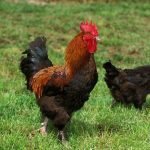
Country of Origin: France
Use: Dual Purpose; Eggs and Meat
Weight Male: 3.5-4 kg
Weight Female: 2.5-3 kg
Skin Color: White
Egg Color: Dark Brown
The Marans, also known as Poule de Marans, is a dual-purpose chicken breed originating from the town of Marans in southwestern France. It is valued for both its meat and its distinctive dark brown eggs, which vary in color from mahogany to chocolate, making it one of the few breeds that produce such darkly colored eggs.
The breed was developed by cross-breeding local feral chickens with imported Croad Langshans to improve their table qualities. It was first shown in La Rochelle in 1914 and a breed society was established in 1929, leading to the creation of the first breed standard in 1931.
Marans come in various color varieties, with ten colors recognized in the French breed standard for large fowl, and five colors recognized in the United Kingdom. Some of the recognized colors include white, black, copper-black, golden cuckoo, silver cuckoo, and more. The French variety typically has feathered legs, while the British variety has unfeathered shanks.
Maran hens lay approximately 150-200 dark brown eggs per year, depending on the variety. They are historically known for their dual-purpose capabilities, as they are not only valued for their unique eggs but also for their meat quality.
While the Marans are well-regarded in France and the United Kingdom, there is some debate about the origin of the British Marans, and it may not be directly connected to the French Marans. Nevertheless, both varieties are cherished for their egg-laying abilities and table qualities.
Marsh Daisy
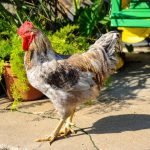
Country of Origin: United Kingdom
Use: Dual Purpose; Eggs and Meat
Weight Male: about 2.95 kg
Weight Female: about 2.5 kg
Skin Color: White
Egg Color: Tinted
The Marsh Daisy is a rare breed of chicken that originated in Lancashire, England. Its name may be related to its origin in a marsh-like area, or to the large rose comb that resembles the flower of the Marsh Daisy (Armeria maritima).
The Marsh Daisy is known for its hardiness and ability to thrive in economical barnyard conditions. However, it is slow to mature compared to other breeds. As a lightweight standard fowl, males typically weigh a maximum of 2.95 kilograms (6.5 pounds), while females weigh around 2.5 kilograms (5.5 pounds). This breed is good at foraging and prefers to be kept free-range. Although generally calm, the Marsh Daisy is an active chicken and is capable of flying. Hens of this breed lay a fair number of tinted eggs. Some of the distinguishing characteristics of the Marsh Daisy are its ‘Rose comb’, ‘white earlobes,’ and ‘willow green legs.’ Breeders find joy in raising this rare breed due to its unique features and hardiness.
The history of the Marsh Daisy dates back to the 1880s in Southport, Lancashire. It was developed by crossing Old English Game roosters with Malay hens, and later adding Black Hamburgs, White Leghorns, and Sicilian Buttercups to establish its defining characteristics. The Marsh Daisy was officially recognized as a breed in England in 1913.
Throughout its history, the Marsh Daisy has remained extremely rare, both domestically and internationally. It has not been recognized for showing by organizations like the American Poultry Association, and it is listed as an endangered breed by the Rare Breeds Survival Trust in the United Kingdom. The breed was once found in various color varieties, including Black, Brown, Buff, Wheaten, and White. Currently, the Wheaten and Brown are the most common varieties, while dedicated breeders have reintroduced the Buff, White, and Black varieties. As of now, there are no bantam versions of the Marsh Daisy. Due to its endangered status, efforts are being made by breeders and conservationists to preserve and promote this unique and hardy breed.
Naked-neck

Country of Origin: Not Clear
Use: Dual Purpose; Eggs and Meat
Weight Male: about 3.9 kg
Weight Female: about 3 kg
Skin Color: Yellow
Egg Color: Light Brown
The Naked Neck, also known as the Transylvanian Naked Neck or Turken, is a breed of chicken that is naturally devoid of feathers on its neck and vent. While the breed is fairly common in Europe, it is rare in North America and very common in South America. The name “Turken” arose from the mistaken belief that the bird was a hybrid of a chicken and a domestic turkey.
The origin of the Naked Neck chicken is not entirely clear, but it is believed to have originated in Asia, where it was bred for cockfighting in some countries. It was later introduced to Transylvania (now part of Romania) and eventually spread to Germany and the rest of Europe, as well as the Americas.
Despite its unusual appearance, the Naked Neck is not primarily known as an exhibition bird but rather as a dual-purpose utility chicken. They are valued for their ability to lay a respectable number of light brown eggs and their suitability for meat production. The Naked Neck’s reduced feathering makes it easier to pluck and contributes to its resistance to hot weather. The breed is also considered to be good foragers and is relatively cold-hardy.
Naked Neck chickens come in various color varieties, including black, white, cuckoo, buff, red, and blue in the United Kingdom and black, white, buff, and red in the United States.
The naked-neck trait in this breed is controlled by an incompletely dominant allele (Na) located near the middle of Chromosome 3. Individuals that are homozygous dominant (Na/Na) or heterozygous (Na/na+) for this allele will exhibit the naked-neck characteristic, though heterozygous individuals may show less reduction in feathering. To be true breeding members of the breed, they must be homozygous dominant (Na/Na). The naked-neck gene has been found to improve breast size and reduce heat stress in chickens of non-broiler breeds that are homozygous for the trait. It has also shown positive effects on body temperature, body weight gain, feed conversion ratios, and carcass traits in broiler strains in tropical climates.
Overall, the Naked Neck is a unique and hardy breed of chicken that has practical benefits for both egg and meat production.
New Hampshire

Country of Origin: United States
Use: Dual Purpose; Eggs and Meat
Weight Male: about 3.9 kg
Weight Female: about 3 kg
Skin Color: Yellow
Egg Color: Brown
The New Hampshire Red, also known as New Hampshire, is an American breed of chicken developed in the early twentieth century in the state of New Hampshire. It was created through selective breeding of Rhode Island Red stock with an emphasis on rapid growth, early maturity, and meat production. The breed was not selected for color, but the resulting birds are typically a light to medium red, which may fade in sunlight.
The New Hampshire Red was developed over about thirty years, involving farmers in the state of New Hampshire and research conducted at the New Hampshire Agricultural Experiment Station in Durham. It was admitted to the American Standard of Perfection in 1935, and the bantam variety was added in 1960. The breed played a role in the development of the Delaware breed in the 1940s.
In 2018, the New Hampshire Red was designated the official poultry of the state of New Hampshire following a proposal from students at Canaan Elementary School. The conservation status of the breed is reported as “not at risk,” with an estimated population of around 3300 birds as of 2015. The Livestock Conservancy lists it as a “watch,” indicating a breed of interest in conservation efforts.
The New Hampshire Red is a medium-large size chicken, with males weighing about 3.9 kg (8.5 lb) and hens approximately 3.0 kg (6.5 lb). The plumage of the red variant varies from a golden bay to a chestnut color, with black tail feathers in males and some black in the tail, neck feathers, and wing primaries of females. The comb is single and five-pointed, and the earlobes and wattles are red.
As a dual-purpose breed, the New Hampshire Red is suitable for both meat and egg production. Hens lay approximately 220 brown eggs per year, weighing about 55 g each. They are good sitters and mothers. The breed is known for its adaptability to different management systems, whether intensive or extensive, and its meaty carcass makes it desirable for both small-scale farms and backyard keepers.
Norfolk Grey

Country of Origin: United Kingdom
Use: Eggs, Meat, and Exhibition
Weight Male: about 3.2 kg
Weight Female: about 2.7 kg
Skin Color: White
Egg Color: Tinted
The Norfolk Grey is a utility breed of chicken that originated near the city of Norwich, in Norfolk, England, around 1910. It was originally created by Frederick W Myhill of Hethel, Wymondham, under the name “Black Maria.” The breed is considered rare and is currently at risk according to the Rare Breeds Survival Trust.
The Norfolk Grey’s history is linked to the First World War when the breed was allowed to free-range while Myhill was away for military service, leading to crossbreeding with other breeds. Upon his return, Myhill had to recreate the strain. The breed was first exhibited as “Black Maria” at the Dairy Show in 1920. However, in 1925, Myhill applied to the Poultry Club of Great Britain to have the name changed to “Norfolk Grey” as the breed did not gain popularity under the original name.
The Norfolk Grey is considered a heavy breed, but it doesn’t grow as large as many other heavy breeds. Its development is not entirely known, but it is believed that Birchen English Game and possibly Duckwing Leghorns were used in its makeup, accounting for its excellent meat and laying abilities. The breed has a single comb, a red face with black eyes, and slate or black legs. The plumage is attractively marked, with males having silver hackles and necks striped with black, while the rest of the plumage is black. Hens have a rich black feathering all over, apart from the throat, which is silver laced.
The Norfolk Grey is an excellent forager and does well when free-ranging. Males reach a weight of 3.2 to 3.6 kg (7.1 to 7.9 lb), while females reach 2.25 to 2.7 kg (5.0 to 6.0 lb). The breed is known for producing approximately 150-220 tinted (pale brown) medium-sized eggs per year, and they are good layers even throughout the winter. Additionally, the cockerels make good table birds if allowed to mature slowly, and their meat has a more gamey flavor compared to other common breeds.
Due to its utility aspects and historical significance, the Norfolk Grey remains an interesting breed, though it faces challenges in maintaining its population, making it an at-risk breed that requires conservation efforts.
Orpington
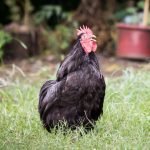
Country of Origin: United Kingdom
Use: Dual Purpose; Eggs and Meat
Weight Male: 3.60-4.55 kg
Weight Female: 2.7-3.6 kg
Skin Color: White
Egg Color: Brown
The Orpington is a British breed of chicken that was developed in the late nineteenth century by William Cook of Orpington, Kent, in southeast England. Cook aimed to create a dual-purpose breed that could be raised for both eggs and meat. The original Black Orpington was bred by crossing Minorcas, Langshans, and Plymouth Rocks to create a new hybrid bird. The breed was selected for its black color, which helped hide the dirt and soot of London, making it suitable for exhibition. The Orpington breed quickly gained popularity and became known as a show bird, though it was initially intended for both utility and exhibition purposes.
Over time, additional color varieties were developed, including white, buff, blue, and splash. Other countries also developed their own color variations. The Bantam version of the Orpington was created in the early twentieth century, featuring a smaller size while retaining the friendly personality of the standard breed.
Orpingtons are known for their heavy, broad bodies with a low stance, fluffed-out feathers that make them appear larger, and a small head with a medium single comb. The breed lays about 175 to 200 medium to large light-brown eggs per year. While they were once capable of laying up to 340 eggs annually, a decline in egg production occurred due to breeders selecting for appearance rather than utility.
In the UK, the Orpington Club is dedicated to the breed, while the United Orpington Club serves American breeders, and the Orpington Club of Australia represents the breed in Australia. The Orpington remains a popular and recognizable breed of chicken, valued for its exhibition qualities and its ability to provide both eggs and meat.
Plymouth Rock

Country of Origin: United States
Use: Dual Purpose; Eggs and Meat
Weight Male: about 3.4 kg
Weight Female: about 2.9 kg
Skin Color: Yellow
Egg Color: Brown
The Plymouth Rock is an American breed of domestic chicken that has been widely kept in the United States since the nineteenth century. It is a dual-purpose bird, valued for its meat and its production of large brown eggs. The breed is known for its resistance to cold weather, ease of management, and good sitting abilities.
The Plymouth Rock’s history can be traced back to its first appearance in Boston in 1849, but it gained more popularity around 1869 when D.A. Upham cross-bred Black Java hens with a barred plumage cock with a single comb. He selectively bred for the barred plumage and clean (featherless) legs, laying the foundation for the modern Plymouth Rock breed. Other chicken breeds, including the Brahma, Cochin, Dominique, and White-faced Black Spanish, may have also contributed to its development.
The Plymouth Rock was included in the first edition of the American Standard of Perfection by the American Poultry Association in 1874. Its barred plumage pattern was the original, and other colors were later added. For much of the early twentieth century, it was the most widely kept chicken breed in the United States. However, with the rise of industrial chicken farming and the development of broiler hybrids, its popularity as a domestic fowl declined.
Today, Plymouth Rock is recognized in various color varieties, including barred, blue, buff, Columbian, partridge, silver-penciled, and white. It is easy to manage, early-feathering, and has good resistance to cold weather. The Plymouth Rock is a dual-purpose breed, known for its meat and large brown eggs, with hens laying approximately 200 eggs per year. In industrial agriculture, it has also been used in crossbreeding to create broiler production stock. The breed’s numbers have seen some recovery, with over 33,000 reported worldwide, indicating its continued significance and popularity among chicken enthusiasts and farmers.
Rhode Island Red

Country of Origin: United States
Use: Dual Purpose; Eggs and Meat
Weight Male: about 3.9 kg
Weight Female: about 3.0 kg
Skin Color: Yellow
Egg Color: Brown
The Rhode Island Red is an American breed of domestic chicken, and it is the state bird of Rhode Island. It was developed in Rhode Island and Massachusetts in the late nineteenth century by cross-breeding birds of Oriental origin, such as the Malay, with brown Leghorn birds from Italy. The deep red plumage of the Rhode Island Red was derived from the Malay breed. Originally a dual-purpose breed raised for both meat and eggs, modern strains have been selectively bred for their excellent egg-laying abilities.
The breed’s history is associated with various names and breeders, including Isaac Champlin Wilbour of Little Compton and Mr. Jenny of the Southern Massachusetts Poultry Association. The name “Rhode Island Red” was first used in 1895, although they were previously known by other names like “Golden Buffs” or “Tripp fowls.” The first breed standard was drawn up in 1898 and was approved by the American Rhode Island Red Club in 1901.
Traditional Rhode Island Reds have lustrous deep pink to almost black plumage, with a mostly black tail. They may have either single or rose-comb varieties, and their combs, wattles, and earlobes are vivid red. The birds have red-orange eyes, reddish-brown beaks, and yellow feet and legs, sometimes with red markings on the toes and shanks. The traditional breed is larger and deeper in color than modern industrial strains.
Originally developed as a dual-purpose breed, the Rhode Island Red lays 200–300 brown eggs per year and produces flavorful meat. However, since the 1940s, selective breeding has focused on egg-laying qualities, making the modern Rhode Island Red primarily a layer breed. The traditional dual-purpose Rhode Island Red is still recognized and valued for its ability to provide both meat and eggs, and it is included in the Ark of Taste of the Slow Food Foundation as a breed of conservation interest.
Rhode Island White
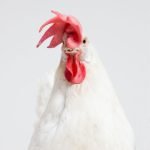
Country of Origin: United States
Use: Dual Purpose; Eggs and Meat
Weight Male: about 3.9 kg
Weight Female: about 3.0 kg
Skin Color: Yellow
Egg Color: Brown
The Rhode Island White is a breed of chicken that originated in Rhode Island, USA. Despite its similar name and place of origin, it is distinct from the Rhode Island Red breed. However, Rhode Island Reds and Whites can be bred together to create Red Sex-Link hybrid chickens, such as the ISA Brown. In Australia, the Rhode Island White is considered a color variety of the Rhode Island breed according to the Australian Poultry Standards.
The breed was developed by J. Alonzo Jocoy of Peacedale, Rhode Island, starting in 1888. Jocoy used crosses of Partridge Cochins, White Wyandottes, and the rose comb type of White Leghorn to create the Rhode Island White. By 1903, it had been solidified as a distinct breed. The American Poultry Association’s Standard of Perfection officially accepted the Rhode Island White in 1922. It was moderately popular until the 1960s but has become relatively rare today. It is listed as a breed to watch by the American Livestock Breeds Conservancy, with fewer than 3,000 birds known to have existed around 2003. The breed also has a bantam variety.
Rhode Island Whites are considered a dual-purpose fowl, suitable for both meat and egg production. The males weigh around 8.5 pounds (3.9 kilograms), and the hens weigh approximately 6.5 pounds (3 kilograms). They have pure white plumage, red wattles and earlobes, and a medium-sized rose comb. The breed is well-regarded for its versatility and productivity in providing both meat and eggs.
Sombor Kaporka
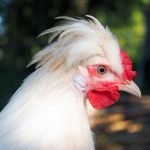
Country of Origin: Serbia
Use: Dual-Purpose; Eggs and Meat
Weight Male: 3.5-4.0 kg
Weight Female: 2.5-3.0 kg
Skin Color: White Pink
Egg Color: White or Cream
The Sombor Kaporka, also known as Sombor Crested, is a Serbian breed of crested chicken that was developed at the beginning of the twentieth century in the Autonomous Province of Vojvodina, located in northern Serbia. It is named after the city of Sombor. The breed’s creation involved cross-breeding imported Sulmtaler and Houdan chickens with local chicken varieties. A breed standard for the Sombor Crested was established around 1918.
The Sombor Crested is a dual-purpose breed, meaning it is raised for both its eggs and meat. Hens of this breed are known to lay approximately 200 to 220 eggs per year, and some individuals may produce as many as 260 eggs annually. This makes them reasonably productive egg-layers. In addition to their egg-laying abilities, they are also raised for their meat.
The breed is recognized for its distinctive crested appearance, which adds to its unique and attractive features. As crested chickens, they have a tuft of feathers on the top of their head, which gives them a distinctive look. The breed has gained recognition and appreciation within Serbia and is valued for its dual-purpose capabilities and appealing appearance.
Scots Dumpy
Country of Origin: United Kingdom
Use: Dual-Purpose; Eggs and Meat
Weight Male: about 3.2 kg
Weight Female: about 2.7 kg
Skin Color: White
Egg Color: White or Cream
The Scots Dumpy is a traditional Scottish breed of chicken known for its very short legs, which cause its body to be only a few centimeters from the ground. This unique characteristic is caused by a recessive lethal allele, which results in chondrodystrophy or dwarfism. The breed has been known by various names, including Bakie, Corlaigh, Crawler, Creeper, and Stumpy.
Scots Dumpies come in both standard-sized and bantam varieties. They are one of the two Scottish breeds of chicken, the other being the Scots Grey.
The breed’s history dates back more than two centuries in Scotland. Some birds of this type were introduced to England in the mid-nineteenth century and were shown at poultry exhibitions. Over time, the Scots Dumpy became one of the rarest British chicken breeds. However, in 1975, a search for surviving stock in Scotland was unsuccessful. Fortunately, two years later, a dozen birds were imported from Kenya, descendants of a small flock taken there in 1902. These birds were used to reconstitute the breed.
The Scots Dumpy comes in various colors, including cuckoo, black, and white. The breed standard allows for any color standardized in other breeds. They have a single bright red comb, small earlobes, and medium-sized wattles. Their legs are extremely short, with shanks no longer than 3.75 cm (1.5 inches), giving them a unique waddling or swimming gait. Despite their short legs, Scots Dumpies are otherwise normal in appearance, with a long, heavy, low-set body, deep breast, broad back, and well-arched tail. They have four toes.
As a dual-purpose breed, Scots Dumpy hens are good layers, producing about 180 white or cream-colored eggs per year. They are also known to be good sitters, making them useful for hatching clutches of game bird eggs. Due to their unique appearance and historical significance, the breed is considered to be at risk, and efforts are being made to preserve and protect it through organizations like the Rare Breeds Survival Trust.
Scots Grey
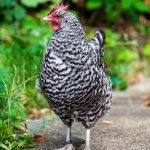
Country of Origin: United Kingdom
Use: Dual-Purpose; Eggs and Meat
Weight Male: about 3.2 kg
Weight Female: about 2.25 kg
Skin Color: White
Egg Color: Cream
The Scots Grey is a dual-purpose breed of domestic chicken with its origins in Scotland, where it has been bred for over two hundred years. Formerly known as the Scotch Grey, it was a popular breed in Scotland until around 1930. However, it is now considered to be at risk and is listed on the “Native Poultry Breeds at Risk” by the Rare Breeds Survival Trust.
The Scots Grey is a tall and upright chicken, similar in appearance to the Scots Dumpy, but with a taller stature. It has a single red comb, along with a bright red face, wattles, earlobes, and comb. The beak and shanks are white, with possible black markings. Its plumage is steel-grey with black barring that has a metallic sheen. While both sexes are similar, hens may have larger markings that give a tartan-like appearance.
As a light breed, the Scots Grey is not particularly large, with cocks weighing around 3.2 kilograms (7 pounds) and hens about 2.25 kilograms (5 pounds). There is also a Scots Grey bantam variety, which is a smaller version of the standard-sized bird.
The breed serves as a dual-purpose chicken, being kept for both its white eggs and its meat. Scots Greys are active and well-suited for free-range management, as they are hardy and excellent foragers. However, hens are not typically prone to going broody, meaning they are less inclined to sit on and hatch eggs. Due to its historical significance and conservation status, efforts are being made to protect and preserve the Scots Grey through organizations like the Rare Breeds Survival Trust.
Sussex

Country of Origin: United Kingdom
Use: Dual-Purpose; Eggs and Meat
Weight Male: about 4.1 kg
Weight Female: about 3.2 kg
Skin Color: White
Egg Color: Tinted
The Sussex is a British breed of dual-purpose chicken, known for being raised both for its meat and its eggs. It has a rich history and originates from the historic county of Sussex in south-east England. The breed is among the oldest of British chicken breeds, with records of birds called “Old Sussex or Kent Fowl” being shown at the first poultry show at London Zoo in 1845.
The Sussex chicken is a graceful bird with a long, broad, and flat back, wide shoulders, and a rectangular build. It has a single comb, red earlobes, and white legs and skin. There are eight recognized color varieties for both standard-sized and bantam Sussex fowl: brown, buff, coronation, light, red, silver, speckled, and white. Each variety has distinct markings and color patterns.
Originally, the Sussex was a popular meat breed in the UK, along with the Rhode Island Red, until the introduction of commercial hybrid strains during World War II. While it was traditionally raised for its meat, it is now kept as a dual-purpose bird, valued for its meat and its ability to lay around 180-200 tinted eggs per year. Some strains may produce up to 250 eggs annually. The eggs weigh approximately 60 grams each.
In addition to its practical use for meat and egg production, the Sussex is also reared for exhibition purposes and showing. Its rich history and versatility have led to its continued popularity and recognition by poultry associations such as the Sussex Breed Club and the American Poultry Association.
Winnebago or Wyandotte
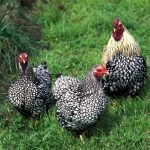
Country of Origin: United States
Use: Dual-Purpose; Eggs and Meat
Weight Male: 3.5-4 kg
Weight Female: 2.7-3.2 kg
Skin Color: Yellow
Egg Color: Brown
The Wyandotte is an American breed of chicken that was developed in the 1870s and named after the indigenous Wyandot people of North America. It is a dual-purpose breed, meaning it is raised for both its brown eggs and its yellow-skinned meat. The Wyandotte is known for its popularity as a show bird and comes in a variety of color variants.
The breed’s history is not entirely clear, but it was created in the United States by four individuals: H. M. Doubleday, John Ray, L. Whittaker, and Fred Houdlette. The silver-laced variety was the first to be recognized and included in the American Standard of Perfection in 1883. Other color varieties such as gold-laced, white, buff, black, partridge, and Columbian were developed through selective breeding.
Wyandottes are of medium to large size, weighing between 2.7 to 4 kilograms (6 to 9 pounds) as adults. They have clean legs, a broad back, and a well-rounded breast. The breed features a rose comb, and the skin and shanks are yellow, while the ear-lobes, face, and wattles are red.
In the United States, nine color varieties are recognized by the American Poultry Association, including black, blue, buff, Columbian, golden laced, partridge, silver laced, silver penciled, and white. In Europe, the Entente Européenne lists thirty colors, and the Poultry Club of Great Britain recognizes several, including barred, blue, blue-laced, and more.
The Wyandotte is a versatile breed, well-regarded for its productivity. It matures at a moderate pace, and hens are known for laying large brown eggs. Additionally, it is appreciated as a meat bird and continues to be popular in show circuits, particularly in Germany. Over time, the breed has experienced varying levels of endangerment, but it has been making a comeback, with conservation efforts helping it recover and thrive.
Exhibition
Since the 19th century, poultry fancy, the art of breeding and exhibiting poultry as a hobby, has significantly impacted chicken breeds. Numerous breeds were traditionally kept for ornamental reasons, while others underwent a transition from their original utility to primarily becoming exhibition fowl, although they might still retain some practical uses. With the prohibition of cockfighting in the developed world, most breeds originally developed for this purpose, known as game fowl, have found their place primarily in show rings rather than the cockfighting pits as fighting cocks.
American Game
Country of Origin: United States
Use: Cockfighting, Ornament, and Meat
Weight Bantam Male: about 850 g
Weight Bantam Female: about 765 g
Egg Color: Brown
Comb Type: Single
The American Game is a breed of game fowl that was originally bred for cockfighting, a practice that is now banned in many countries due to its cruelty. The breed comes in various color varieties and is also kept for ornamental purposes. The standard-sized American Game is not recognized by the American Poultry Association and is not listed in various international poultry organizations’ databases.
The American Game Bantam, on the other hand, is a bantam version of the breed that was developed in New Jersey in the 1940s by a breeder named Frank Gary. He crossed the wild Red Jungle Fowl with fighting bantams known as “pit game” to create the American Game Bantam. This smaller version of the breed was officially recognized by the American Poultry Association in 2009 and comes in ten color varieties, including birchen, black, black-breasted red, blue, blue red, brown red, golden duckwing, red pyle, silver duckwing, and white.
The standard-sized American Game is bred in a wide range of plumage colors, and the male birds have long sickle feathers. The bantam version has a small single comb with five points and small smooth wattles and earlobes.
Originally, the American Game was bred for cockfighting, a brutal and inhumane practice that involves pitting the birds against each other to fight to the death. Cockfighting is now illegal in many countries, and the breed is no longer used for this purpose. However, the American Game is still considered a good table bird, and hens are known to lay medium to large brown eggs. For exhibition purposes, the comb, earlobes, and wattles of the birds may be cut off, a practice known as “dubbing.”
The conservation status of the American Game was listed as “study” by the Livestock Conservancy in 2020, indicating that efforts were being made to study and preserve the breed. However, as of 2021, it is no longer listed, and its current conservation status is not mentioned.
Asil
Country of Origin: India
Use: Cockfighting, and Meat
Weight Male: 3-6 kg
Weight Female: about 2.6 kg
Egg Color: Tinted, Cream to Brown
The Asil, also known as Aseel, is a group of Indian game chicken breeds known for their fighting abilities. They are distributed across much of India, particularly in states like Tamil Nadu, Andhra Pradesh, Chhattisgarh, and Odisha. Asil chickens have also been exported to several other countries and are found throughout much of Southeast Asia.
The term “Asil” comes from Arabic and means “purebred.” In India, it is a general term used for all fighting breeds of chickens. As one of the parent breeds, the Asil played a significant role in the development of the Indian Game breed, which was created in the West Country of England in the early nineteenth century.
Asil is believed to be one of the oldest breeds of fighting cock in the Indian subcontinent, which includes modern-day India, Pakistan, Bangladesh, and Sri Lanka. It is a hardy and resilient breed that has been historically used for fighting purposes.
There are various varieties of Asil, each with its own unique characteristics. Some of the well-known types include Amroha, Bhaingam, Kilimooku, Kulang, Lasani, Madras, Mianwali, Reza, and Sindhi.
Asil hens are not known for their egg-laying capabilities, producing only around 70 eggs per year. The eggs they lay are relatively small, weighing approximately 40 grams, and come in various shades, ranging from cream-colored to brownish.
In terms of conservation status, Asil was not in need of conservation in 2005, and the FAO listed its global status as “not at risk” in 2007. However, in 2021, its status was reported as “unknown,” and the Livestock Conservancy in the United States listed it as “threatened,” indicating that there might be concerns about its population and conservation efforts.
Appenzeller Barthuhn
Country of Origin: Switzerland
Use: Ornament, and Eggs
Weight Bantam Male: 2.0-2.3 kg
Weight Bantam Female: 1.6-1.8 kg
Egg Color: White
The Appenzeller Barthuhn is a Swiss breed of bearded chicken originating from the historical Appenzell region of Switzerland. It is one of two chicken breeds native to that area, the other being the Appenzeller Spitzhauben. The only other Swiss breed of chicken is the Schweizer.
The Barthuhn was developed around 1860 in the Appenzell region and is believed to have been bred from a combination of Italiener, Polverara, and Russian Bearded chicken stock. A man named Züst, from the district of Vorderland in the Canton of Appenzell Ausserrhoden, played a significant role in its breeding efforts. His aim was to create a bearded and rose-combed chicken that could better withstand cold weather.
The breed was officially recognized in 1898. In the 1990s, a bantam version of the Barthuhn was bred by E. Meier of Bottenwil, in the Canton of Aargau.
The Barthuhn is a light chicken, with hens typically weighing around 1.6–1.8 kg, while cock birds are slightly heavier at about 2.0–2.3 kg. The breed is recognized by the Entente Européenne in three colors: partridge, black, and blue-laced, although some sources mention only the first two colors. The Poultry Club of Great Britain allows any color seen in any breed of game fowl.
Regarding their utility, hens of the Barthuhn breed are moderate layers, producing around 150 white-shelled eggs per year during their first year of laying. The average weight of these eggs is approximately 55 g.
A flock book for the Barthuhn breed was initiated in 2005, and as of 2019, the recorded population consisted of 334 hens and 205 cocks. Despite its relatively small population, efforts are being made to conserve and preserve this Swiss heritage breed.
Appenzeller Spitzhauben
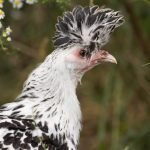
Country of Origin: Switzerland
Use: Ornament, and Eggs
Weight Bantam Male: 2.0-2.3 kg
Weight Bantam Female: 1.6-1.8 kg
Egg Color: White
The Appenzeller Spitzhauben is a Swiss breed of crested chicken that originated in the historical Appenzell region of Switzerland. It is one of two chicken breeds native to that area, the other being the Appenzeller Barthuhn, and the only other Swiss breed of chicken is the Schweizer.
The exact origins of the Spitzhauben are unknown, but it has been bred in the Alpine mountains region for centuries. A similar breed, the Brabanter, was depicted in paintings from the seventeenth century, leading to speculation that the Spitzhauben may have originated around that time.
By the mid-twentieth century, the Spitzhauben was on the brink of extinction and was only found in the historical Appenzell region of Switzerland. In 1983, a recovery project was initiated with the assistance of ProSpecieRara, and efforts were made to revive the breed. The population slowly increased, and a flock-book was established in 2005 to document and preserve the breed. As of 2019, the recorded population consisted of 243 hens and 153 cocks.
The Spitzhauben is a light and active breed, with hens weighing just over a kilogram and cock birds weighing slightly over 1.5 kg. They are known for their distinctive V-comb and feather crests in both males and females, resembling the pointed bonnets worn by women in the Appenzeller region. The silver-spangled variety is the most common, and other recognized colors include gold-spangled, lemon-spangled, chamois-spangled, pure black, and pure blue.
While the Spitzhauben is relatively rare in North America, it is recognized officially by the Entente Européenne Standard Commission in Europe. The breed is known for its foraging abilities and prefers free-range environments. They are not well-suited for close confinement and may roost in trees if given the opportunity.
As for their utility, Spitzhauben hens are moderate layers, producing around 150 white-shelled eggs per year during their first year of laying. The average weight of these eggs is approximately 55 g.
Barbu de Watermael
Country of Origin: Belgium
Use: Ornament
Weight Bantam Male: 600-700 g
Weight Bantam Female: 450-550 g
Comb Type: Spined Rose
The Barbu de Watermael, also known as the Watermaalse Baardkriel in Dutch, is a Belgian breed of bantam chicken. It gets its name from the Belgian town of Watermael-Boitsfort, where it originated. The name “Barbu de Watermael” translates to “bearded [chicken] from Watermael.” This breed is closely related to the Barbu d’Anvers, but it is distinguished by its small, backswept crest of feathers.
The Barbu de Watermael is one of the more recent Belgian bantam breeds, with its creation attributed to Antoine Dresse at the estate of La Fougères in Watermael-Boitsfort. The exact date of its creation is not well-documented, but it is believed to have happened in the early 20th century, possibly around 1915. The exact breeds used to create the Barbu de Watermael remain unknown, but it is certain that the Barbu d’Anvers played a role in its development. Dresse confirmed that Polish chickens were not used in the breeding process, as the distinct cranial protuberance of that breed would be considered a fault in the Barbu de Watermael. The breed was first exhibited in 1922 but did not gain significant popularity at that time. Breeders’ clubs were later formed in France and the Netherlands, contributing to the breed’s conservation efforts.
The Barbu de Watermael is among the smallest bantam breeds, with males weighing around 600-700 grams and hens weighing approximately 450-550 grams. It is primarily kept for ornamental purposes due to its small size and unique features. The breed is known for its narrow backswept crest, three-part beard, and distinctive spined rose comb. In Belgium, more than thirty color varieties are recognized, with black, brown red, buff Columbia, cuckoo, quail, and white being some of the more commonly seen colors. However, some of the other color varieties are rare, with only one breeder known to have them. As of 2010, the Barbu de Watermael is the second bantam breed in Belgium in terms of numbers, with a population of 764, and is considered to be “in danger” at that time.
Belgian Bearded d’Anvers
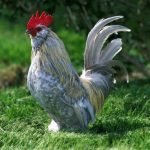
Country of Origin: Belgium
Use: Ornament
Weight Bantam Male: about 700 g
Weight Bantam Female: about 600 g
Egg Color: Creamy White
Comb Type: Rose
The Barbu d’Anvers, also known as the Antwerpse baardkriel in Dutch, is a Belgian breed of bantam chicken. It is a true bantam, meaning it has no full-sized counterpart, and its males typically weigh about 700 grams while hens weigh around 600 grams. The Barbu d’Anvers is considered one of the oldest bantam breeds and is believed to have originated in the province of Antwerp in northern Flanders, Belgium.
This breed has a long history and is thought to have descended from small bearded chickens in the Low Countries, as depicted in the paintings of Aelbert Cuyp during the 17th century. The first reliable written reference to the Barbu d’Anvers dates back to 1858, and a more detailed description was provided by Victor La Perre De Roo in 1882. Interest in the breed grew around 1890, and by 1910, the Club Avicole du Barbu Nain, the breeder’s club, had nearly 500 members.
Unlike some other Belgian bantam breeds that are at risk of extinction, the Barbu d’Anvers remains relatively safe, and a census in 2005 reported 1500 birds in Belgium. This bantam breed has a tail-less variant called the Barbu de Grubbe and is considered the ancestor of other Belgian bantam breeds such as the Barbu d’Uccle and the Barbu d’Everberg.
The Barbu d’Anvers is a small chicken with a distinctive round breast that protrudes forward and an arching tail. As its name suggests, it has a thick beard of feathers covering its earlobes. This breed typically has a small rose comb and may have small or non-existent wattles. There are 29 recognized color varieties of plumage in Belgium, with an additional six recognized in Germany.
The Barbu d’Anvers is primarily kept as an ornamental breed, often as pets or for showing by poultry enthusiasts. The hens lay small, creamy white eggs weighing less than 35 grams. They are known for being good mothers and broody sitters, making them an attractive option for those interested in raising ornamental chickens.
Bearded d’Uccle

Country of Origin: Belgium
Use: Ornament
Weight Bantam Male: about 750 g
Weight Bantam Female: about 650 g
Egg Color: Creamy White
Comb Type: Rose
The Barbu d’Uccle, also known as the Belgian d’Uccle or Ukkelse Baardkriel in Dutch, is a bearded bantam chicken breed that originated in the town of Uccle, near Brussels in central Belgium, in the early 20th century. It is a true bantam, meaning it has no standard-sized large fowl counterpart, and it is one of eleven Belgian true bantam breeds.
The Barbu d’Uccle was developed by Michael Van Gelder of Uccle, Belgium, with the guidance of Robert Pauwels and Louis Vander Snickt. While it is believed that the breed was created by cross-breeding existing Sabelpoot and Barbu d’Anvers bantam breeds, the exact parentage is not entirely certain. The breed was first shown in 1905, and initial colors included millefleurs and porcelain, with black, white, and cuckoo being added soon after. By 1909, the breed had become well-established, and it was first exported to the United Kingdom in 1911. The millefleur variety was later recognized by the American Poultry Association in 1914.
Over time, the Barbu d’Uccle faced challenges, including the impact of the World Wars, and its population declined. However, a breed society, the Club belge du Barbu d’Uccle, was formed in 1969 to promote and conserve the breed. Despite being listed as “critical” in terms of conservation status in the 21st century, the Barbu d’Uccle remains the third-most numerous true bantam breed in Belgium.
The Barbu d’Uccle has a characteristic low posture, a full beard, a muff, and heavily feathered legs. Unlike the Barbu d’Anvers, it has a single comb. The recommended weight for cock birds in the Netherlands is 700–800 grams, while hens weigh about 550 grams. The French standard suggests average weights of 750 grams for males and 650 grams for females. The American standard specifies an ideal weight of 26 oz (740 grams) for cocks, 22 oz (620 grams) for hens and cockerels, and 20 oz (570 grams) for pullets.
The Barbu d’Uccle is recognized in various color varieties, with twenty-eight listed in Belgium, including blue, blue quail, cuckoo, millefleur, porcelain, lavender, lavender quail, black, black mottled, silver quail, quail, and white. The American Poultry Association recognizes seven varieties: black, golden neck, millefleur, mottled, porcelain, self-blue, and white. The breed is primarily kept for ornamental purposes and is admired for its unique appearance and small size.
Belgian d’Everberg
Country of Origin: Belgium
Use: Ornament
Weight Bantam Male: 700-800 g
Weight Bantam Female: 550-650 g
Egg Color: Creamy White
The Barbu d’Everberg, also known as the Everbergse Baardkriel in Dutch, is a Belgian bantam chicken breed. It is a tailless variant of the Barbu d’Uccle and was first bred around 1906 at the Château d’Everberg, located in the municipality of Kortenberg, between Brussels and Leuven in Belgium.
As a true bantam, the Barbu d’Everberg has no standard-sized large fowl counterpart. Cocks of this breed typically weigh between 700 to 800 grams, while hens weigh around 550 to 650 grams.
Unfortunately, the Barbu d’Everberg is considered one of the most endangered chicken breeds in Belgium, and as of 2010, its conservation status was classified as “critical.” Efforts are being made to preserve this breed and prevent its extinction.
While the Barbu d’Everberg is recognized as a separate breed by the Entente Européenne, in some regions like Britain and the Netherlands, it is considered a variant of the Barbu d’Uccle rather than a distinct breed. This may be due to its close similarity to the Barbu d’Uccle and its tailless characteristic, which distinguishes it from other bantam breeds.
Blue Hen of Delaware
Country of Origin: United States
Use: Ornament
Weight Male: about 2.5 kg
Weight Female: about 2 kg
Comb Type: Single
The Delaware Blue Hen, also known as the Blue Hen of Delaware, is a blue strain of American gamecock. While it is not a recognized chicken breed, it holds historical significance and is the official bird of the State of Delaware. The name “Blue Hen” dates back to 1775 and has several different accounts of its origin.
One story links the name to the men of the 2nd company of the First Delaware Regiment during the Revolutionary War. These soldiers, mostly recruited in Kent County, carried blue game chickens with them that gained a reputation for their fighting ability. As a result, they became known as “Blue Hen’s Chickens.” Another tale suggests that Captain Jonathan Caldwell, who led the company, had two gamecocks hatched from a blue hen, leading the soldiers to call themselves the “Sons of the Blue Hen.” It is also possible that the nickname arose due to their uniforms resembling the plumage of a fighting cock.
The Blue Hen Chicken was officially adopted as the state bird of Delaware on April 14, 1939.
The sports teams of the University of Delaware are called the Blue Hens, and their mascot, YoUDee, is inspired by this bird. The university maintains a small flock of Blue Hens, cross-breeding them with Blue Andalusian birds from Spain, resulting in changes in their appearance and characteristics. They are now Mediterranean in appearance, with differences in body shape, size, and coloration compared to the original fighting birds.
Additionally, the Blue Hen is the emblem of the 166th Airlift Wing and its 142nd Airlift Squadron, stationed in Delaware. While the Blue Hen may not be a recognized breed, its historical significance and symbolic value continue to be celebrated in Delaware’s culture and institutions.
Booted Bantam
Country of Origin: Netherlands
Use: Ornament
Weight Male: about 850 g
Weight Female: about 650 g
Egg Color: White or Tinted
The Booted Bantam, also known as the Dutch Booted Bantam, is a true bantam chicken breed characterized by abundant feathering on the feet and shanks, giving it a “booted” appearance, and vulture hocks – long, stiff feathers on the backs of the thighs, which is the origin of the Dutch name “Sabelpoot.”
The history of the Booted Bantam is complex, involving aspects of Belgian bantams, the German Federfüßige Zwerghühner, Dutch Sabelpoot, and bantams in the United Kingdom. Feather-footed bantams have existed in Europe for centuries, with early depictions found in works by Ulisse Aldrovandi, Aelbert Cuyp, and Eleazar Albin. Eleazar Albin’s description in 1738 attributes these birds to “Bantam in India.”
Booted Bantams were documented in the United States by 1836, and by 1867, they were described in detail in William Tegetmeier’s “The Poultry Book.” The breed is present in both white and black color variants.
The Booted Bantam has a compact body with a pronounced U-shaped neck, back, and tail line. Its legs have well-developed vulture hocks and heavily feathered shanks and feet. The wings are large and point downwards, and it has a single upright comb with five to seven points.
There are numerous color variants of the Booted Bantam, with thirty-three listed by the Entente Européenne and fourteen in the British Poultry Standards. In the United States, five color variants are recognized by the American Poultry Association.
Booted Bantams are primarily kept for show purposes. Hens may lay approximately 120 eggs per year, with an average weight of 30 g, varying in color from tinted to white.
Interestingly, the Barbu d’Uccle, a bearded and feather-footed bantam breed, was created by cross-breeding Booted Bantams with Barbu d’Anvers stock in the early 20th century.
Cochin
Country of Origin: China
Use: Ornament
Weight Male: 3.6-5.9 kg
Weight Female: 3.2-5.0 kg
Egg Color: Brown
Comb Type: Single
The Cochin is a breed of large domestic chicken known for its distinctive feather-legged appearance. It originated from very large feather-legged chickens brought from China to Europe and North America in the 1840s and 1850s. Initially known as “Shanghai” birds, they were later called “Cochin-Chinas.” The Cochin gained significant popularity, along with other large feather-legged breeds like the Brahma, contributing to a surge of interest in poultry breeding, often referred to as “hen fever.”
The Cochin was included in the first edition of the Standard of Excellence in Exhibition Poultry in the UK in 1865 and the Standard of Excellence of the American Poultry Association in the US in 1874. Recognized colors for full-sized Cochins include black, blue, buff, cuckoo, partridge, and grouse, among others, while the bantam varieties have even more colors listed, including frizzled feathers in some cases.
The most distinctive feature of the Cochin is the excessive plumage that covers its legs and feet, with the skin beneath being yellow. While the Cochin has been mainly bred for exhibition purposes, it is also a good layer of large tinted eggs and is known for being a good sitter and mother. However, its meat tends to be coarse and dark, and capons slaughtered at an age of 12–16 months are preferred for a large table bird.
Crèvecœur
Country of Origin: France
Use: Dual-Purpose; Meat and Eggs; Fancy
Weight Male: 3-3.5 kg
Weight Female: 2.5-3 kg
Egg Color: White
Comb Type: V-Shaped
The Crèvecœur is an endangered historic breed of crested chicken originating from the Pays d’Auge in Normandy, France. It is one of the oldest French chicken breeds, and its origins are uncertain. The breed takes its name from the commune of Crèvecœur-en-Auge, near Lisieux.
The Crèvecœur chicken is related to other Norman breeds like La Flèche, Caumont, Caux, and the now-extinct Pavilly. At the Exposition Universelle of 1855 in Paris, Crèvecoeur chickens received prizes for their unique qualities. The breed was described in detail by Louis Bréchemin in 1894, and the breed standard was officially accepted by the Société d’Aviculture de Basse-Normandie in 1909.
During the two World Wars, the Crèvecœur population in France suffered, and it was believed to have almost disappeared. However, efforts to recover the breed began in 1976. By 2007, the Crèvecœur was classified as “endangered” by the FAO due to its low population.
The Crèvecœur is commonly black, but other recognized colors include blue, white, and cuckoo. The chicken has a crest similar to that of the Houdan breed and has a V-shaped comb like that of La Flèche. The face, comb, earlobes, and wattles are bright red, while the legs and feet are slate blue or black. The breed was originally kept for both egg-laying and meat production, but now it is primarily raised for poultry exhibition.
Bantam versions of the Crèvecœur were developed separately in the United States and Germany, providing smaller versions of the breed. Despite its historical significance and distinctive appearance, the Crèvecœur faces the challenge of low population numbers and the risk of extinction, making conservation efforts crucial for its survival.
Croad Langshan
Country of Origin: China
Use: Eggs, Show
Weight Male: 3.5-5 kg
Weight Female: 2.5-3.5 kg
Egg Color: Brown
Comb Type: Single
The Croad Langshan is an old, heavy, soft-feathered chicken breed that likely originated in China. The breed was first imported to Britain in 1872 by Major F.T. Croad, who brought them from the Langshan area in China. Major Croad’s niece, Miss A. C. Croad, played a significant role in establishing the breed in Britain, leading to the formation of the Croad Langshan Club in 1904.
The Langshan breed was also imported to North America in 1878, and it was admitted to the American Poultry Association standard in 1883. The standard included three varieties: Black, White, and later Blue in 1987. In Germany, the breed was introduced in 1879, and the German Langshans were derived from these birds.
The Croad Langshan is a large chicken with a deep and long breast carried well forward. The back is long and sloping, and the tail rises sharply, giving it a characteristic ‘U’ shape. The head is small compared to the body, and the comb is medium-sized, single, and upright in both males and females. The shanks and outer toes are slightly feathered. Originally, the males weighed over 10 lbs, but today, cocks weigh 9.5 lbs, and hens weigh 7.5 lbs.
Croad Langshans were popular as a utility breed in the early 20th century and were known for their productivity. Hens lay around 140-150 eggs per year, which are dark brown with a plum-colored bloom. They are good winter layers and are excellent sitters and mothers. The breed is easily tamed and adapts well to various living conditions, thriving in suitable conditions.
Throughout history, the Langshan bloodline has been used in creating various other chicken breeds, such as Barnevelders, Black Orpingtons, and Marans. Today, the Croad Langshan is recognized for its historical significance, excellent meat quality, and utility purposes. The breed is also known for its dark plum-colored eggs and is valued for its adaptability and productivity.
Dragon Chicken
Country of Origin: Vietnam
Use: Show
Weight Male: 5.5-6 kg
Weight Female: 4.5 kg
Dong Tao chicken, also known as Dragon Chicken, is a rare and unique breed originating from the village of Đông Tảo near Hanoi in Vietnam. This chicken breed is renowned for its enlarged feet, which make it quite distinct from other chicken breeds.
Traditionally, Dong Tao chickens were considered a delicacy in Vietnam and were bred exclusively for serving the royal family and mandarins. They have a special cultural significance and are highly valued for their meat.
Breeding Dong Tao chickens can be challenging due to their large legs, which can make hatching difficult. Additionally, they are sensitive to changes in temperature. The hens often break their eggs with their bulky legs, making natural hatching difficult. As a result, eggs are typically kept in an incubator for successful hatching.
It takes a relatively long time for Dong Tao chickens to reach maturity, typically eight months to one year. At this stage, they weigh around three to five kilograms, with the males possibly reaching up to six kilograms in weight.
Given their rarity, size, and cultural significance, Dong Tao chickens are highly prized, and their meat can command a high price in the market. The meat is considered a delicacy and may be priced at 350,000 to 400,000 VND per kilogram in Vietnam.
Dutch Bantam
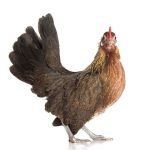
Country of Origin: Netherlands
Use: Eggs, Show
Weight Male: 500–550 g
Weight Female: 400–450 g
Egg Color: White
Comb Type: Single with 5 Points
The Dutch Bantam, also known as Hollandse Kriel in Dutch, is a breed of bantam chicken originating in the Netherlands. It is a true bantam, meaning it is naturally small without any related large fowl from which it was miniaturized. The Dutch Bantam is mainly kept for exhibition purposes due to its unique and attractive appearance, and it comes in various color varieties.
The breed’s history dates back hundreds of years in the Netherlands, although its exact origins are unclear. It is believed that the ancestors of the Dutch Bantam were small bantams brought back by sailors from the Dutch East Indies. Over time, these diminutive chickens were selectively bred, possibly due to the need for small eggs to be kept by peasant farmers while larger eggs were sent to the landed gentry.
The Dutch Bantam was officially recognized by the Nederlandse Hoender Club, the Dutch national poultry club, in 1906. It was later exported to other countries, including the United States and the United Kingdom, where it gained popularity. The American Poultry Association recognized the Dutch Bantam in its Standard of Perfection in 1992, initially in two colors, with four more colors added later.
Dutch Bantams are among the smallest true bantam breeds, with cock birds weighing up to 550 grams and hens up to 450 grams. They have a partridge pattern as the original type of plumage. Despite their small size, they are good fliers due to their light weight and relatively large wings.
These chickens are friendly in temperament, but somewhat flighty, and they are not particularly cold-hardy due to their small size and comb type. Dutch Bantams are known for being good layers, producing around 160 cream or white eggs per year, despite their diminutive size. They are also good brooders and mothers, making them suitable for hobbyists and backyard keepers in need of bantam-sized birds.
Frizzle
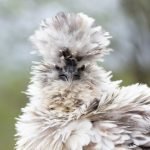
Country of Origin: Unknown
Use: Fancy
Weight Male: 3.2–3.6 kg
Weight Female: 2.25–2.7 kg
Egg Color: White or Tinted
Comb Type: Single
The Frizzle is a distinct breed of chicken known for its characteristic curled or frizzled plumage. While the frizzle gene can be found in many chicken breeds, the Frizzle is recognized as a separate breed in various European countries and Australia. However, in the United States, frizzled chickens are not considered a distinct breed and are judged based on the standards of the breed they belong to.
The exact origin of the Frizzle breed is unknown, but it is believed that the frizzle gene originated in Asia, and frizzled chickens have been reported in the Far East since the eighteenth century. The Frizzle breed is the result of selective breeding for exhibition purposes.
The frizzle gene is incompletely dominant over normal plumage, meaning not all members of the breed have frizzled feathers. Frizzled birds are heterozygous for the gene, and when two frizzled birds are bred, their offspring inherit the gene in the usual Mendelian 1:2:1 ratio: 50% are frizzled like the parents, 25% have normal feathers, and 25% are “over-frizzled,” with brittle feathers.
The Frizzle has a single comb and is clean-legged, without feathers on the shanks. It is known for being a good forager and hardy bird. The breed comes in various recognized colors, depending on the country’s standards.
As for its use, the Frizzle is primarily reared for exhibition purposes. It is a good layer of white or tinted eggs and is known to frequently go broody. The Frizzle is a unique and eye-catching breed that attracts attention at poultry shows and exhibitions.
Hamburg
Country of Origin: Netherlands, Germany
Use: Fancy, Eggs
Weight Male: 2–2.5 kg
Weight Female: 1.6–1.8 kg
Egg Color: White
Comb Type: Rose
The Hamburg, also known as Hollands hoen in Dutch and Hamburger in German, is a breed of chicken that is believed to have originated in Holland, and in some sources, Hamburg, Germany, prior to the fourteenth century. The name may be spelled as Hamburgh in the United Kingdom and Australia.
The Hamburg is a small to medium-sized breed, with cocks weighing around 2 to 2.5 kg and hens weighing about 1.6 to 1.8 kg. They have slender legs and a neat rose comb. There are various color varieties recognized in Germany and Holland, including silver-spangled, gold-spangled, gold-penciled, citron-penciled, silver-penciled, white, black, and citron-spangled. The American standard of perfection includes six of these color varieties. Additionally, there are Bantam Hamburgs, which are smaller versions of the breed.
Hamburgs are known for maturing quickly and are considered good egg producers. They lay eggs that weigh around 50 g with glossy white shells. The breed’s small size, attractive appearance, and good egg-laying abilities make it popular among poultry enthusiasts and backyard chicken keepers.
Houdan
Country of Origin: France
Use: Fancy, Eggs, Meat
Weight Male: 2.5–3 kg
Weight Female: 2–2.5 kg
Egg Color: White
Comb Type: Shaped like a Butterfly or Oak-Leaf
The Houdan, also known as Poule de Houdan, is an old French breed of domestic chicken named after its area of origin, the commune of Houdan in the département of Yvelines, west of Paris. This breed belongs to the crested chicken group, characterized by having a crest on their heads, and it is also muffed and bearded. One distinctive feature of the Houdan is its unusual leaf-shaped comb, and it has five toes on each foot, which is unique compared to the usual four toes in most chicken breeds.
The exact origins of the Houdan breed are unknown, but it has been documented since the 19th century. Some possible ancestors speculated to have contributed to its development include the Crèvecœur, Dorking, and Polish breeds.
The most common color variety of the Houdan is mottled, with a pattern of black and white spotting. Other recognized color varieties include black, pearl-grey, and white, among others. It is considered a light breed, with cocks weighing around 2.5 to 3 kg and hens weighing about 2 to 2.5 kg.
The Houdan was historically used as a dual-purpose fowl, raised for both eggs and meat, but over time, its use for meat production decreased, and it has become primarily a show breed. The hens are moderate egg layers, producing around 140 to 160 white eggs per year.
Due to its unique appearance and historical significance, the Houdan is considered an endangered breed, and efforts are made to preserve and promote it in modern times.
Japanese Bantam
Country of Origin: Japan
Use: Fancy
Weight Male: 510–620 g
Weight Female: 400–510 g
Egg Color: Cream or Tinted
Comb Type: Single
The Japanese Bantam, also known as Chabo (Japanese: 矮鶏), is a distinctive ornamental chicken breed from Japan. It is a true bantam breed, meaning that it has no larger counterpart. The Chabo is characterized by very short legs, a trait resulting from hereditary chondrodystrophy, and a large upright tail that reaches much higher than the head of the bird.
The exact origins of the Chabo are uncertain, but it is believed to have derived through selective breeding from fighting chickens, which were the ancestors of modern Shamo breeds. The earliest recognizable depiction of a Chabo in Japanese art dates back to the beginning of the seventeenth century.
The breed was exported to Europe and the United States around the time of the Meiji Restoration in Japan, which effectively opened the country to foreign trade. The Japanese Bantam made its way to the United Kingdom in the 1860s and was described in William Tegetmeier’s “The Poultry Book” in 1867. A breed society, the Japanese Bantam Club, was later formed in the UK during the Crystal Palace Poultry Show of 1912.
The Japanese Bantam is known for its short legs, a trait caused by the creeper gene, Cp, which displays standard behavior of recessive lethal alleles. This gene results in short-legged birds, making up 50% of offspring, while 25% die in the shell due to being homozygous for the lethal allele, and 25% develop longer legs, making them unsuitable for showing.
The breed comes in various color varieties, with different countries recognizing different colors. In western countries, there are many recognized colors, including black, blue, buff, wheaten, white, and more. There are also frizzle-feathered, Silkie-feathered, and hen-feathered variations of the Chabo.
In Japan, several types of Chabo are recognized, including the bearded Okina Chabo, two varieties of Higo-Chabo (Dorama and Taikan) with unusually large combs, and the black-skinned black Shinguro Chabo.
The Japanese Bantam is primarily kept for ornamental purposes due to its unique appearance and distinctive traits.
Jangmigye
Country of Origin: Korea
Use: Exhibition
Weight Male: 1.2–1.8 kg
Weight Female: 0.8–1.3 kg
Egg Color: Light Brown
Comb Type: Single
The Jangmigye is a breed of long-tail fowl that originated in Mahan, an ancient region in Korea. In Korean, the breed is known as 긴꼬리닭 (Ginkkori-dak), which translates to “long-tail chicken” in English. The name “긴” stands for long, “꼬리” for tail, and “닭” for chicken.
The Jangmigye is characterized by its long tail, which is a distinctive feature of the breed. It is described as a single-comb variety with Black Breasted Red plumage, as well as White plumage. In the Black-breasted Red variety, the comb is single. The legs of the Jangmigye are dark gray (lead), and their eyes are red-brown. The earlobes of the breed are either described as red mixing with white or completely white.
In terms of size, the males of the Jangmigye weigh between 1.2 to 1.8 kg, while the females weigh approximately 800g to 1.3 kg.
The Jangmigye breed is a part of Korea’s rich poultry heritage and is appreciated for its unique appearance and long-tail characteristic.
La Flèche
Country of Origin: France
Use: Exhibition, Eggs, and Meat
Weight Male: 3.5–4 kg
Weight Female: 3–3.5 kg
Egg Color: Light Brown
Comb Type: Two Vertical Spikes
The La Flèche, or Poule de La Flèche, is a rare French breed of dual-purpose domestic chicken originating from the Sarthe département in the Pays de la Loire region of France. It is named after the town and commune of La Flèche, located near Le Mans, the capital of Sarthe. The breed was historically renowned for the high quality of its meat. However, following the Second World War, the population of La Flèche chickens drastically declined, leading to its current status as a rare breed.
The origins of the La Flèche breed are believed to date back to the fifteenth century, with early descriptions of the breed dating as far back as 1846. The breed experienced popularity and success during the early part of the twentieth century, but like many native French chicken breeds, except for the Bresse, its numbers declined significantly after the war.
In the 1960s and 1970s, the La Flèche breed faced the risk of extinction, but gradual efforts have led to its recovery since then. In 2011, a rescue project was initiated by the Conservatoire des races animales en Pays de la Loire, which is the regional animal breed conservation body of the Pays de la Loire region.
The most distinctive feature of La Flèche chickens is their unusual V-shaped comb. They are medium-sized birds, with males typically weighing between 3.5 to 4 kg, and hens weighing around 3 to 3.5 kg.
La Flèche hens are good layers, producing approximately 180 white eggs per year, with an average weight of 60 g. Despite its rare status, the breed remains appreciated for its unique characteristics and historical significance in the region.
Malay
Country of Origin: Unknown
Use: Exhibition
Weight Male: about 5 kg
Weight Female: about 4.1 kg
The Malay is a distinct breed of game chicken known for its impressive size and height, making it one of the tallest chicken breeds. Standing over 90 cm (36 inches) tall, the Malay is predominantly bred in Europe, Australia, and the United States. Its origins can be traced back to the early 19th century when large game chickens were imported to England from the Indian subcontinent or Southeast Asia.
These imported birds, sometimes referred to as Grey Chittagong when from India, were selectively bred by English breeders and became fashionable in England, particularly in Devon and Cornwall. They were also found in Ireland and shown at the first British poultry exhibition in 1845. Malays made their way to Germany and the Netherlands around 1834 and reached the United States by 1846.
The breed was named after the Malay Peninsula, although it is believed that the chickens were more widespread in northern India and Indonesia as well. Malays were initially bred for their size and game qualities but later were also selected for improved egg-laying abilities. However, their egg production remains relatively low compared to commercial laying breeds.
Over time, a bantam version of the standard-sized Malay was created, making it the first chicken breed to be bantamized. Today, Malays are primarily kept by breeders and enthusiasts for participation in poultry shows. They are considered hard-feathered gamefowl and are known for their upright stance, well-muscled form, and large skull.
In Brazil, Malay chickens were used in the creation of the Índio Gigante Chicken, which is known for its exceptional size and stature. While the Malay breed is still appreciated for its unique characteristics and historical significance, its numbers in the United States are very low, and its conservation status is listed as “critical” by the FAO.
Modern Game
Country of Origin: United Kingdom
Use: Exhibition
Weight Male: 3.20–4.10 kg
Weight Female: 2.25–3.20 kg
The Modern Game is a breed of ornamental chicken that originated in England between 1850 and 1900. Developed purely for exhibition purposes, the Modern Game was intended to epitomize the visual appeal of the gamecock or fighting cock, but without the intent to fight. After cockfighting was outlawed in Britain in 1849, many enthusiasts turned to breeding chickens for shows, leading to the creation of the Modern Game through crosses of Old English Game and Malays.
Although they are classified as game chickens due to their cockfighting derivation in breed standards, Modern Games were never bred for fighting. They were included in the first edition of the British Poultry Standard in 1865, with various color variations represented. Some of the most common color varieties include black-red, birchen, brown-red, duckwing, and pyle. The breed appears in standard and bantam sizes, with the bantam version being the more popular choice among poultry fanciers.
The ideal show bird should have a flat iron-shaped body when seen from above, a short back, fine tail, hard feathering, and an upright carriage. The comb and wattles are required to be dubbed (cut off) from all cocks and cockerels being shown after November 1st, reflecting their fighting bird heritage.
Modern Game chickens are not known for their egg-laying capabilities or meat production. They are primarily kept by competitive breeders and poultry enthusiasts who appreciate their unique appearance and show qualities. In terms of temperament, Modern Games are friendly, curious, and easily tamed, making them suitable pets for suburban poultry keepers.
Nankin
Country of Origin: United Kingdom
Use: Ornamental
Weight Male: 680–740 g
Weight Female: 570–620 g
Egg Color: Tinted
Comb Type: Single or Rose
The Nankin Bantam, also known as Nankin, is a British bantam breed of chicken. It is a true bantam, meaning it is naturally small and has no large counterpart from which it was miniaturized. The breed is of Southeast Asian origin and is considered one of the oldest true bantam breeds. Its name is believed to come from the color of nankeen cotton from China, as it has a yellowish buff color.
The Nankin breed has a long history in England, with evidence of its presence dating back to the 16th century. It played a significant role in the development of other bantam breeds like the Sebright. Over time, its popularity declined with the introduction of newer and more exotic Asian breeds. However, the use of broody Nankin hens to incubate game bird eggs helped to keep the breed from disappearing completely.
In North America, interest in Nankins was renewed in the 1960s, and the breed gained recognition from poultry associations. Today, Nankins are recognized by the American Bantam Association and have been accepted into the American Poultry Association’s Standard of Perfection.
The Nankin breed is considered critically endangered, with limited numbers in both the United States and the UK. It is primarily raised for fancy and exhibition purposes due to its unique appearance and historical significance. The hens are good layers and sitters, with very small, creamy white eggs. However, Nankins are not suitable for meat production, as they mature slowly and are not known for their meat yield.
Old English Game
Country of Origin: England
Use: Ornamental
Weight Male: up to 2.94 kg
Weight Female: up to 2.50 kg
Egg Color: White Tinted
Comb Type: Single
The Old English Game is a British breed of domestic chicken that is believed to have originally been bred for cockfighting. Today, it is mainly kept for exhibition and show purposes due to the prohibition of cockfighting in 1849. There are two different standards recognized by the Poultry Club of Great Britain: Carlisle Old English Game and Oxford Old English Game. Additionally, there is a bantam version of the breed.
The Old English Game comes in a wide variety of colors, with different standards recognizing different numbers of color variants. For example, the American Poultry Association recognizes twenty-eight colors, while the Entente Européenne d’Aviculture et de Cuniculture lists thirty-three. In Britain, there are thirteen recognized colors for the Carlisle type and thirty for the Oxford type.
As for their use, Old English Game hens are not particularly prolific layers, producing approximately forty small tinted eggs in a year. However, their primary role in modern times is as show birds, where they are bred for their distinct characteristics and beauty. While they may have historical roots in cockfighting, the breed is now celebrated for its aesthetic qualities rather than any aggressive tendencies.
Pekin
Country of Origin: United Kingdom
Use: Ornamental
Weight Male: up to 680 g
Weight Female: up to 570 g
Egg Color: White or Cream
Comb Type: Single
The Pekin Bantam is a British breed of bantam chicken that originated from birds brought to Europe from China in the nineteenth century. It is named after the city of Peking (now Beijing) in China, where it was believed to have originated. The breed is a true bantam, meaning it has no corresponding large fowl counterpart.
The history of the Pekin Bantam is somewhat uncertain. It is said that the first Pekins were looted from the private collection of the Emperor of China during the Second Opium War around 1860. However, some sources suggest that a consignment of birds from China around 1835 was given to Queen Victoria, and these birds, known as ‘Shanghais,’ were later bred with further imports to develop the Pekin breed.
Pekin Bantams have a distinctive appearance with their round shape and a slight forward tilt to their carriage, making their heads slightly closer to the ground than their elaborate tail feathers. They are abundantly feathered, especially around the tail, and come in a variety of colors, including black, blue, buff, cuckoo, mottled, barred, lavender, white, and more.
In terms of temperament, Pekin Bantams are known to be docile and gentle, especially with regular handling, making them ideal pets for families with children. However, cockerels can become aggressive and territorial once they reach sexual maturity.
Pekin hens are regularly broody and are good sitters and attentive mothers. They are not prolific egg layers, and some may lay a few eggs even during the winter months. Due to their heavily feathered feet, care must be taken to keep their foot feathering clean to prevent issues like foot rot or lameness. Trimming vent feathers may also be necessary to maximize fertility when breeding.
Phoenix

Country of Origin: Japan; Germany
Use: Ornamental
Weight Male: up to 2.5 kg
Weight Female: up to 1.8 kg
Egg Color: Cream or Tinted
Comb Type: Single
The Phoenix is a German breed of long-tailed chicken that was created in the late nineteenth century by Hugo du Roi, the first president of the National German poultry association. The breed was developed through cross-breeding delicate imported long-tailed Japanese birds, similar to the Onagadori, with other breeds, including Combattant de Bruges, Krüper, Leghorn, Malay, Modern Game, Old English Game, Ramelsloher, and Yokohama.
The Phoenix breed’s name is not officially recognized by the Poultry Club of Great Britain, which groups it together with the Yokohama breed. However, in the United States, the silver variety of the Phoenix was accepted into the American Poultry Association Standard of Perfection in 1965, and the gold variety in 1983. The black-breasted red variety was recognized in 2018. In Australia, the Phoenix was accepted into the poultry standard in 2012, with any color standardization from the Old English Game accepted.
The Phoenix has a distinctive long tail, though it does not reach the same remarkable lengths as the original Japanese Onagadori stock due to the absence of a specific recessive gene. Nonetheless, the tail of a Phoenix chicken can still reach lengths of 90 cm or more. The breed is known for its attractive and ornamental appearance, especially due to its long, flowing tail feathers.
Polish
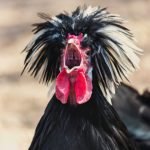
Country of Origin: Poland
Use: Ornamental
Weight Male: up to 2.75 kg
Weight Female: up to 2 kg
Egg Color: White
Comb Type: V-Type
The Polish or Poland is a European breed of crested chickens known for its distinctive crest of feathers that nearly covers the entirety of the head. The exact origins of this breed are uncertain, but the oldest accounts of these birds come from The Netherlands. They are named “Polish” due to various theories, including a possible association with Poland or the Middle Dutch word “pol,” meaning head, referring to their dome-shaped skull.
Polish chickens are primarily bred as ornamental birds and are famous for their remarkable appearance. They have a small V-shaped comb, which is often hidden by the large crest of feathers. The earlobes and wattles are also small and may be obscured by the crest or “beard” feathers in some varieties. Due to the crest’s size, Polish chickens may have limited vision, which can affect their temperament, making them more timid and easily frightened.
Originally, Polish chickens were productive egg layers, especially in France, where they were known for being excellent egg producers. However, today, they are mostly bred for show and as ornamental birds. Polish chickens are noted for their white eggs and are not known for going broody. There are several varieties of Polish chickens, including bearded, non-bearded, and frizzle varieties, each with unique features and appearances. The breed was introduced to the United States between 1830 and 1840 and was accepted into the American Poultry Association’s Standard of Perfection in several stages starting in 1874.
Rosecomb
Country of Origin: United Kingdom
Use: Ornamental
Weight Male: up to 620 g
Weight Female: up to 510 g
Comb Type: Rose
The Rosecomb is a bantam breed of chicken known for its distinctive rose comb, which is large compared to its overall body size. It is one of the oldest and most popular bantam breeds, with records dating back to the 14th century in Britain. The breed’s popularity as an ornamental chicken grew after King Richard III began raising them.
Rosecombs are primarily kept for competitive poultry showing due to their striking appearances and various color variations. They have a compact body shape, substantial white earlobes, and prodigious tails. The breed comes in 25 different color variations, with black, blue, and white being the most common.
Selective breeding for appearance has resulted in some drawbacks for the Rosecomb breed. They are poor egg layers and are not suitable for meat production. Roosters may have low fertility due to a genetic trait tied to rose-combed chickens. Hens rarely brood their own clutches, and chicks may have higher mortality rates. However, adult birds are generally hardy and active, and they are known for their ability to fly, which is unusual for chickens.
Rosecombs are usually friendly birds, but roosters can be aggressive. They are prized for their ornamental value and are a popular choice for poultry enthusiasts and competitive breeders.
Sebright
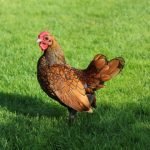
Country of Origin: United Kingdom
Use: Fancy
Weight Male: up to 620 g
Weight Female: up to 510 g
Egg Color: White
Comb Type: Rose
The Sebright is a British breed of bantam chicken, one of the oldest and most popular bantam breeds known for its distinctive laced plumage and ornamental appearance. It is a true bantam, meaning it has no corresponding large fowl counterpart. The breed was created by Sir John Saunders Sebright in the early 19th century through selective breeding.
Sebrights are very small in size, with males weighing around 22 ounces and females around 20 ounces. They have short backs, large breasts, and downward-pointing wings, giving them a jaunty appearance. The breed comes in two recognized color variants in the United Kingdom, gold, and silver, with a base of dark gold or whitish silver, evenly laced with black around the edges.
One of the unique characteristics of Sebrights is that the males are hen-feathered, meaning they lack the long, sickle-shaped feathers typical of male chickens. This characteristic has made them valuable for scientific studies on sex hormones.
Sebrights are primarily kept for ornamental purposes and are commonly seen in competitive poultry shows. They are not known for their egg-laying abilities or meat production. Breeding Sebrights can be challenging due to their unique characteristics and potential fertility issues in males. They are generally hardy but susceptible to Marek’s disease, and chicks may have higher mortality rates.
Serama
The Serama, also known as the Ayam Serama in Malay, is a bantam breed of chicken originating in Malaysia. It is one of the smallest chicken breeds in the world, weighing under 500 grams on average, and even smaller birds under 250 grams have been bred in Malaysia. The breed is characterized by its upright posture, full breast, vertical tail feathers held tightly to the body, and vertical wings held down nearly touching the ground.
The origins of the Serama are not entirely clear, but it is believed to have been developed through the crossing of Japanese and Malaysian Bantams. Some stories suggest that the breed originated from a gift of small chickens from the King of Thailand to a local sultan in ancient times. Small chickens have been popular as pets in Malaysia, often referred to as “ayam katik” (pygmy chickens) and “ayam cantik” (pretty chickens).
The modern breed is credited to Wee Yean Een from Kelantan, Malaysia, who named it “Serama” after the title of the Kings of Thailand. The breed was first exhibited in 1990 and became popular in poultry shows, particularly in Malaysia. Seramas are known for their confident and assertive stance, but they are calm and manageable, making them easy to handle. They are often described as brave warriors or archangel chickens due to their human-like appearance.
Seramas have been introduced and promoted in other countries as well, including the United States and various European countries. The breed has gained acceptance by poultry associations in these regions, and different organizations work to standardize and promote various varieties of Serama.
The breed’s appearance and characteristics vary slightly depending on the region and standard they are bred to, but overall, Seramas are prized for their small size, confident stance, and unique posture. They are primarily kept for ornamental purposes and are not known for their egg-laying abilities or meat production. Breeding Seramas can be challenging due to their small size and specific traits, but they are popular among poultry enthusiasts for their charming and distinctive features.
Shamo
Shamo (軍鶏) is a general term used for gamefowl in Japan, and there are seven recognized breeds of Shamo chicken in the country, all designated as Natural Monuments of Japan. These breeds are believed to have originated from fighting chickens of Malay type that were brought from Thailand in the early 17th century.
The name “Shamo” is a corruption of “Siam,” which was the historical name for Thailand. The breed first entered Japan during the early Edo period (1603-1867). Although it originated from Thailand, the Shamo has been selectively bred for several centuries and has undergone significant changes from the original stock. In Japan, Shamo chickens are used for naked-heeled cockfighting, which is still legal in the country. They are also bred worldwide for their show quality and distinctive upright posture.
The Shamo breeds are categorized based on weight:
- O-Shamo: Large fowl category
- Chu-Shamo: Medium fowl category
- Nankin-Shamo: Bantam chicken category
- Ko-Shamo: Ornamental breed, not used for cockfighting, but bred for temperamental traits resembling a fighter.
- Kinpa, Yakido or Ygido, and Yamato-Shamo or Yamato Gunkei are other recognized Shamo breeds.
In the West, different countries recognize varying Shamo breeds. In the United Kingdom, Shamo, Ko-Shamo, Nankin Shamo, Yakido, and Yamato Gunkei are recognized as distinct breeds. Chu-Shamo and Chibi Shamo receive a mention in the British Poultry Standards. The Entente Européenne recognizes Shamo, Ko-Shamo, Yakido, and Yamato Gunkei, but lists Chu-Shamo and Nankin Shamo as unrecognized. The Australian Poultry Standards have only one form of Shamo, with a minimum weight of 3 kg. In the United States, the American Poultry Association recognizes Shamo as a breed, both full-sized and bantam.
Silkie
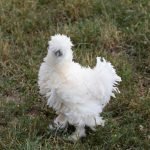
Country of Origin: China
Use: Fancy
Weight Male: 0.9–1.4 kg
Weight Female: 0.7–0.9 kg
Egg Color: Cream or Tinted
Comb Type: Walnut
The Silkie chicken is a unique and distinct breed known for its atypically fluffy plumage, which feels like silk and satin. They have several unusual characteristics, such as black skin and bones, blue earlobes, and five toes on each foot (most chickens have four). Silkies are popularly exhibited in poultry shows and come in various colors, such as black, blue, buff, lavender, partridge, splash, white, and more.
Originating from ancient China, the Silkies are one of the most well-documented breeds, with references from Marco Polo’s travels in Asia during the 13th century. They likely made their way to the West through trade routes like the Silk Route. In the 21st century, Silkies are a popular ornamental breed kept as pet chickens and for their broody nature, as they are excellent at hatching eggs from other breeds and species.
Silkies are relatively small chickens, with males weighing around 1.8 kilograms (4 pounds) and females weighing about 1.4 kilograms (3 pounds). They have a soft and fluffy appearance due to their unique feathers lacking functioning barbicels, making them unable to fly.
The breed comes in two varieties: bearded and non-bearded, and they have distinguishing colors and physical characteristics, such as small walnut-shaped combs, dark wattles, turquoise-blue earlobes, and five toes on each foot. Silkies have black or bluish skin, bones, and meat, and they are often referred to as “black-boned chickens” in Chinese.
In addition to their ornamental value, Silkies are used for their unique black meat in Asian cuisines. In Chinese cuisine, Silkie meat is considered a gourmet food, and they are used in various dishes such as soups, braised dishes, and curries. Some fusion restaurants in the West have also incorporated Silkie meat into traditional dishes.
Overall, Silkies are treasured for their distinctive appearance, calm and friendly temperament, and excellent brooding capabilities, making them a beloved breed among poultry enthusiasts worldwide.
Sultan

Country of Origin: Turkey
Use: Ornamental
Weight Male: upto 2.75 kg
Weight Female: upto 1.8 kg
Egg Color: White
Comb Type: Duplex
The Sultan is a unique and ornamental breed of crested chicken that originates from Turkey. The name “Sultan” comes from the Turkish name “Sarai-Tavuk,” which means “fowls of the palace,” indicating their historical presence in the gardens of the Ottoman sultanate.
Primarily kept for ornamental purposes, Sultans have always been admired for their decorative plumage and were historically associated with royalty. They were first exported from Turkey in 1854 when Ms. Elizabeth Watts of London brought a small flock to Britain. They were later seen in North America in 1867 and officially recognized by the American Poultry Association’s Standard of Perfection in 1874.
Sultans are known for their impressive crests, beards, long tails, and profuse foot feathering, giving them a highly decorative appearance. Their small V-shaped combs are mostly hidden under their feathering. One unique characteristic of Sultans is that they have five toes on each foot, which is rare among chicken breeds. They come in three color varieties: black, blue, and white, with white being the most well-known variety.
Despite their captivating appearance, Sultans are relatively small compared to other large chicken breeds. Males weigh around 2.7 kilograms (6 pounds), and hens weigh about 2 kilograms (4 pounds). There is also a bantam version of the Sultan breed.
In terms of their egg-laying capabilities, Sultans are not prolific layers. Hens lay small white eggs at a slow rate and are not known for being broody (incubating eggs to hatch chicks).
Sultans are mostly bred for competitive showing in poultry fancy and are considered a rare sight in the Western world. Their striking appearance and historical significance make them a prized and cherished breed among poultry enthusiasts.
Sumatra
Country of Origin: Indonesia
Use: Ornamental
Weight Male: 2.25–2.70 kg
Weight Female: upto 1.80 kg
Egg Color: White, Light Creamy
Comb Type: Pea
The Sumatra is a breed of chicken that originates from the island of Sumatra in Indonesia. These chickens were originally brought to the United States and Europe in 1847 as fighting cocks for entertainment purposes. However, today they are primarily kept for exhibition and ornamental purposes. In 1883, Sumatra was officially recognized and admitted to the American Standard of Perfection.
Sumatras are known for their attractive plumage and are primarily kept for their ornamental value. They typically have lustrous black feathers with a green sheen throughout their body and tail. The breed also comes in blue and white varieties, and there is an unstandardized “splash” variety, which is a result of breeding blue chickens.
Cocks of the Sumatra breed weigh around 2.25 to 2.70 kilograms, while hens weigh approximately 1.80 kilograms. While they are visually appealing, hens of this breed are not prolific layers, producing around 100 white creamy eggs per year. They are also known to be exceptionally broody, meaning they have a strong inclination to sit on and hatch eggs.
Both male and female Sumatras have small to nonexistent wattles, and males may have multiple spurs on each leg. One unique trait of Sumatra is its strong flying ability, unlike many modern chicken breeds. They have retained this characteristic, which harks back to their natural behaviors as birds.
Overall, Sumatras are a fascinating and attractive breed of chicken, prized for their striking appearance and historical significance. Today, they are primarily kept for exhibition in poultry shows and as ornamental additions to backyard flocks.
Vorwerk

Country of Origin: Germany
Use: Ornamental
Weight Male: 2.5–3.0 kg
Weight Female: 2.0–2.5 kg
Comb Type: Single
The Vorwerk is a breed of chicken that originates from Germany. It was developed in the early 20th century by poultry breeder Oskar Vorwerk, who aimed to create a medium-sized, utilitarian fowl with the belted plumage pattern of the Lakenvelder breed. The key difference was the Vorwerk’s distinctive dark golden base color, compared to the white of the Lakenvelder.
Breeds used to create the Vorwerk included the Lakenvelder, Buff Orpington, Buff Sussex, and Andalusian. By 1913, the Vorwerk was standardized, but it never gained widespread popularity and remains a rare breed, particularly outside of Continental Europe.
Vorwerks are considered dual-purpose chickens, suitable for both meat and egg production. The standard-size males weigh around 2.5 to 3.2 kilograms (5.5 to 7.5 pounds), while females weigh approximately 2 to 2.5 kilograms (4.5 to 5.5 pounds). They are hardy and adaptable birds with moderate appetites, making them economical to keep.
In terms of plumage, Vorwerks have a distinctive black-and-gold pattern. Their head, neck, and tail are solid black, while the rest of their body is a buff color. The ideal breed standard calls for no black spotting in the buff areas, although this can be challenging to achieve in practice. Vorwerks have a single comb, slate grey under fluff, and white earlobes.
Vorwerk chickens are known for their cream-colored eggs, and hens can produce approximately 170 eggs per year. They are alert and active birds, but not excessively flighty in temperament. There are also bantam versions of Vorwerks, which have been developed independently in the United States and Europe and have been recognized by the American Bantam Association.
Yokohama
Country of Origin: Germany
Use: Ornamental
Weight Male: 2.0–2.5 kg
Weight Female: 1.3–1.8 kg
Egg Colors: Tinted
Comb Type: Walnut or Pea
The Yokohama is a fancy breed of chicken with distinctive characteristics, such as unusual coloring and very long tail feathers. It was created by Hugo du Roi in the 1880s and derives from ornamental birds brought to Europe from Japan in the 19th century. Some of these birds were shipped from the Japanese port of Yokohama, hence the name.
In Germany, the term “Yokohama” is used only for white or red-saddled birds. However, in the United Kingdom, it is also used for birds known elsewhere as Phoenix, which come in various colors.
The Yokohama breed was among the chickens exported to Europe after Japan opened its ports to foreign trade in the mid-19th century. The first documented export was in 1864. The chickens reached various European countries, including Germany, where Hugo du Roi began breeding them. He might have created the red-saddled coloration through cross-breeding, or it might have already existed in birds brought from Japan.
The Yokohama is a small chicken with a long tail and trailing saddle feathers. It has a pea- or walnut comb, and its beak, legs, and feet are yellow. In Germany, the recognized colors are white and red-saddled, while the UK recognizes several more colors, such as black-tailed buff, blue-red, spangled, black-red, golden duckwing, and silver duckwing.
Yokohamas are primarily kept for showing and exhibition purposes. Full-sized hens lay around 80 tinted eggs per year, weighing about 40 grams, while bantam hens lay about 90 eggs per year, weighing about 30 grams on average.
Conclusion
In conclusion, the world of chicken breeds is a fascinating tapestry of diversity, with each breed possessing unique characteristics and histories. From the ancient origins of some breeds to the more recent developments, poultry enthusiasts have continuously sought to create and preserve distinct varieties of chickens for various purposes.
Throughout the article, we have explored a myriad of chicken breeds, ranging from popular and widely recognized to rare and lesser-known gems. Each breed serves a specific role, whether it be for egg production, meat, ornamental purposes, or even as exhibition showstoppers.
As we delved into the rich history of chicken breeds, we learned about the influences of different cultures, regions, and historical events that have shaped the development of these remarkable fowl. The ingenuity and dedication of breeders in refining and preserving certain traits and characteristics in each breed have contributed to the vast array of chickens we see today.
Moreover, we have observed how chicken breeds have not only adapted to human needs but also how humans have come to appreciate and celebrate the beauty and uniqueness of each breed. From the gentle and docile nature of the Silkie to the regal and impressive presence of the Brahma, every breed has its admirers who appreciate and cherish its individuality.
The article also highlighted the role of chicken breeds in contributing to various aspects of human life, from providing sustenance through eggs and meat to offering entertainment and pleasure through poultry shows and exhibitions. The utilization of chickens in cultural traditions, folklore, and even culinary delights further showcases their significance in human societies worldwide.
As we celebrate the vast diversity of chicken breeds, we are reminded of the vital role that these domesticated birds play in our lives and history. Whether in rural farms or urban backyards, chickens have carved a place in our hearts and homes.
In the end, our journey through the world of chicken breeds leaves us with a sense of awe and appreciation for the breadth of life’s wonders. As we continue to cherish and preserve these breeds for future generations, we honor the heritage and contributions of these remarkable creatures that have been our companions for millennia.

